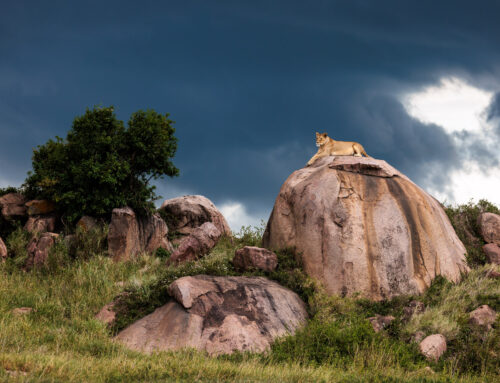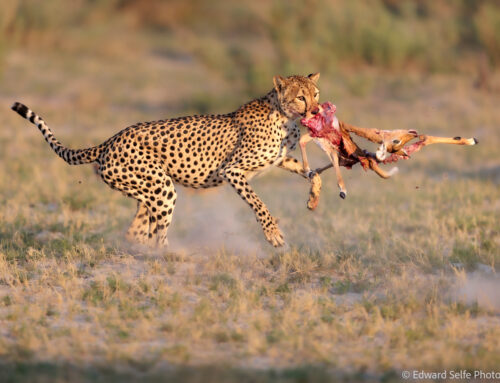Day 1:
Our September photo safari has started in true Luangwa style (as the photos below show!) with some great sightings. But sadly we are two people short as Roger and Vicky’s flight was cancelled at the last minute. They are repeat guests of mine and I’m looking forward to them arriving tomorrow after rescheduling their flight.
So we started out with only 4 last evening, on a cool and cloudy afternoon. The light was very poor, so we took time to photograph some zebras with a view to a B&W conversion later. They were feeding on sausage fruit and stood nicely for us as we discussed their behaviour and also some camera settings. I worked out each of my guests’ camera techniques which allows me to offer them some pointers at other times.
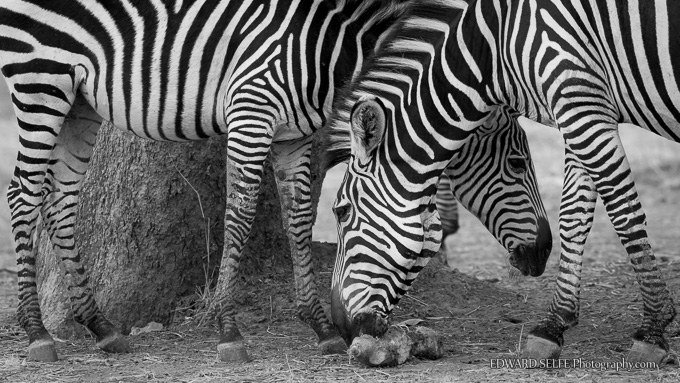
Heading down to my favourite plain, we found a large group of elephants, made up of perhaps 3 herds. As we arrived, another herd was approaching across the plain and as the female caught our scent, she raised her trunk to get a better idea of what we were.
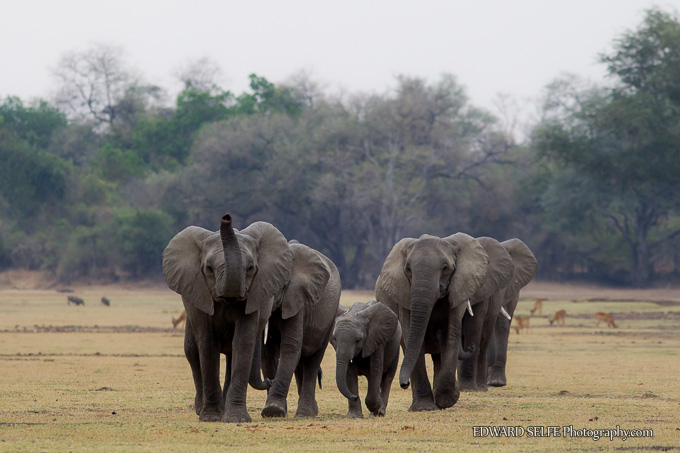
Not long after this, commotion nearby led us to a pack of Wild Dogs which one of my guests had seen in the morning. What he hadn’t mentioned was that the pack of 4 adults now had 2 puppies with them! I had never seen Wild Dog pups so was very excited, and almost forgot to take photos as I was enjoying the view. The light was really poor by now (ISO 3200 and upwards) so we took photos as best we could and then enjoyed watching the interaction.
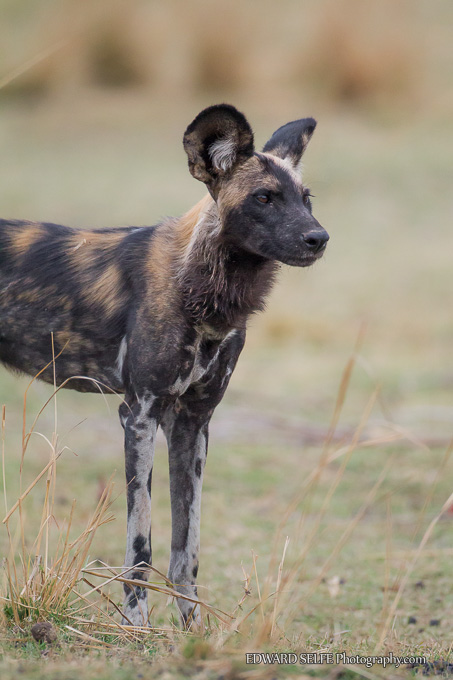
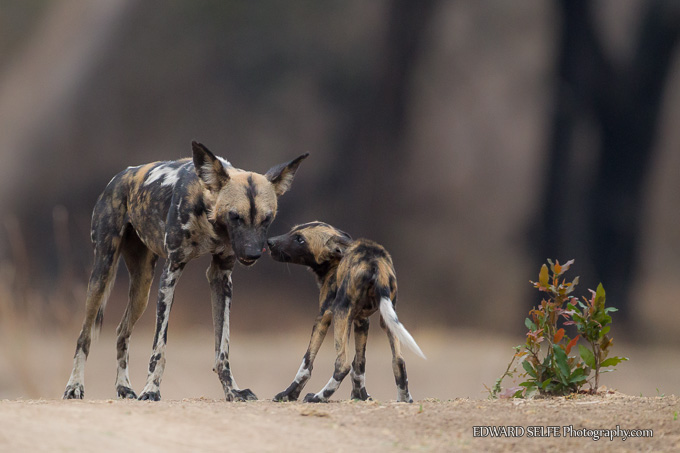
At one point, the pack took on an adult warthog boar, but quickly thought better of it when the pig turned and faced them!
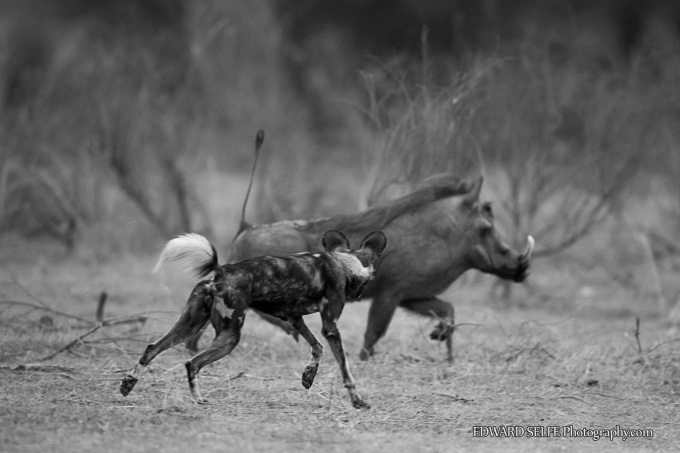
Not deterred, they decided to take out their frustration on a hyaena, who yelped and ran away as the dogs nipped at his heels.
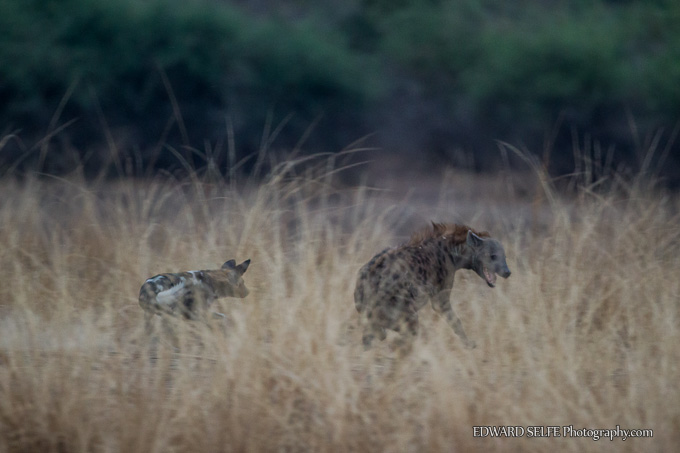
After following the dogs, we lost them in the thickets, so returned and found a hyaena resting in the middle of the road.
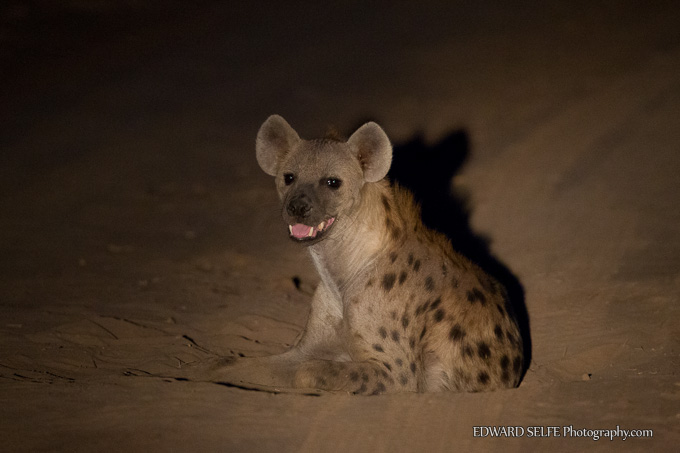
Later in the evening, we tracked down a young male leopard and my group got some good photos.
OVERNIGHT AT FLATDOGS CAMP
This morning, we set out early and enjoyed watching bee-eaters bringing insect-gifts to their mates in nest holes in the river bank. The light was golden and I liked the simple composition here.
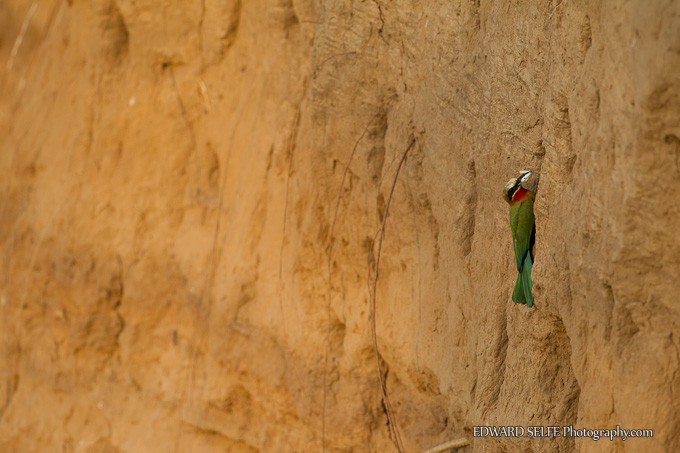
While we watched a small group of elephants came across the river.
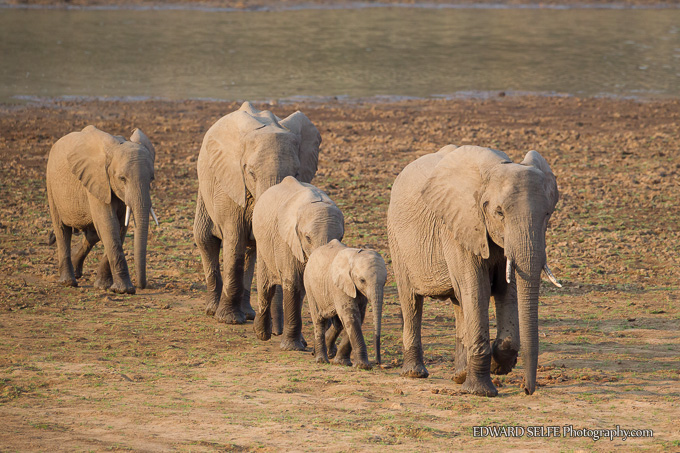
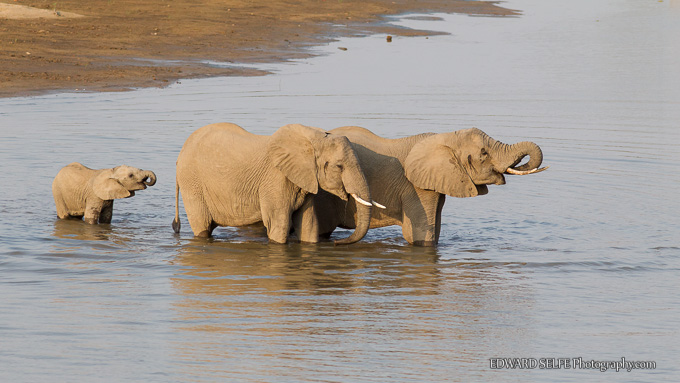
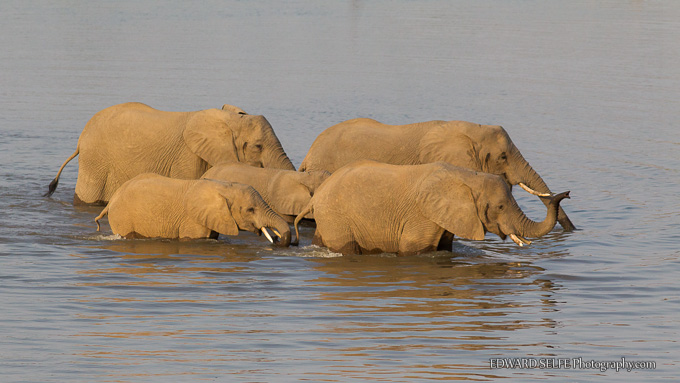
And then they dust-bathed after leaving the water.
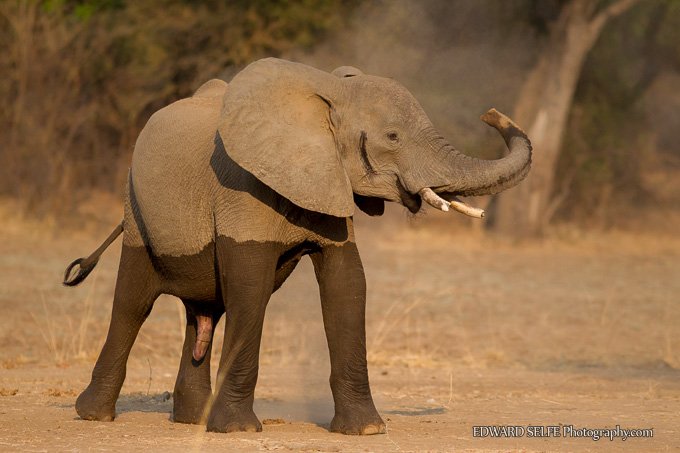
Setting off again, we returned to a thicket where I’d heard squirrels calling in the early morning, and we found a leopard in a tree!! A female who is known well to us was posing on a flat branch.
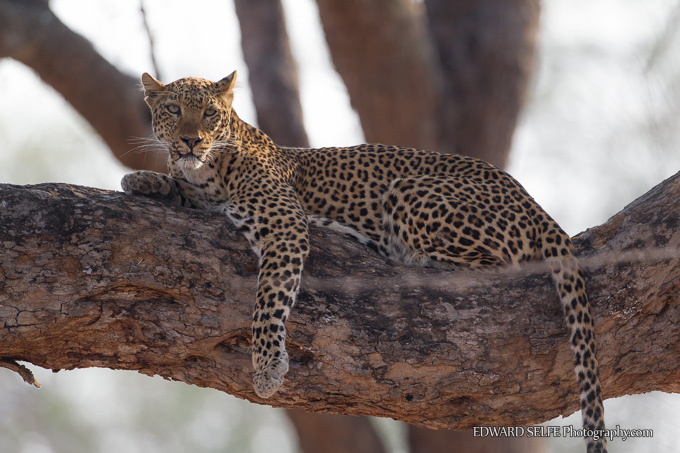
But she was very much alert and on the hunt, so I suspected she would come down and pursue the baboons that were chattering in the distance. She came down and hid in a thicket waiting for prey to pass but was sadly spotted by the baboons and she had to move off.
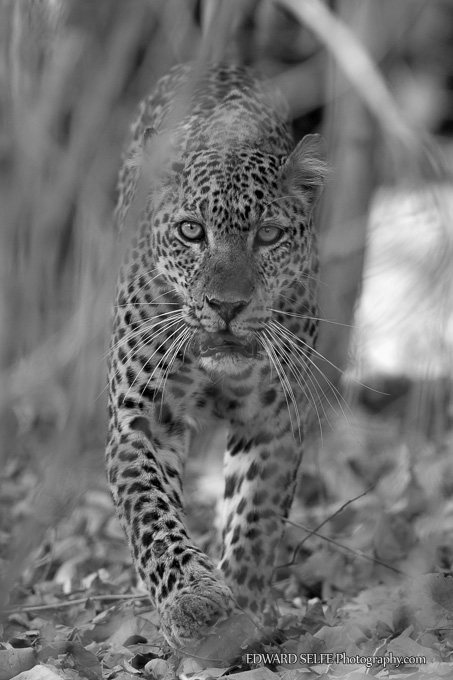
We headed to a nearby lagoon to see if anything was drinking (as it was getting hot by now) and found a buffalo stuck in the mud and the crocodiles circling. But the lions were also there – 3 females and 5 cubs. They didn’t hang around long as it was hot but they will surely take on the buffalo when night falls.
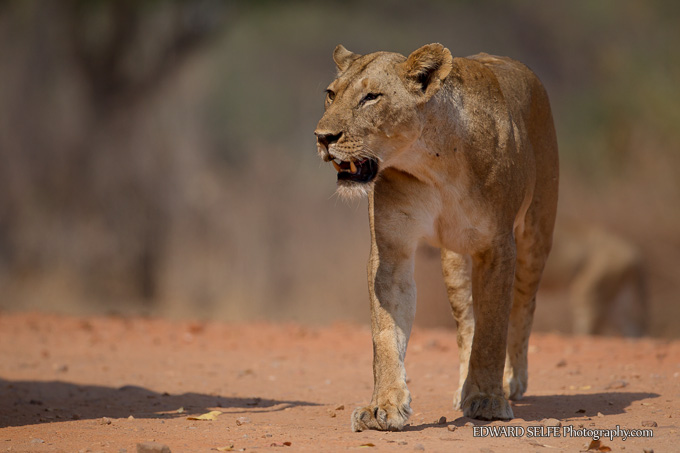
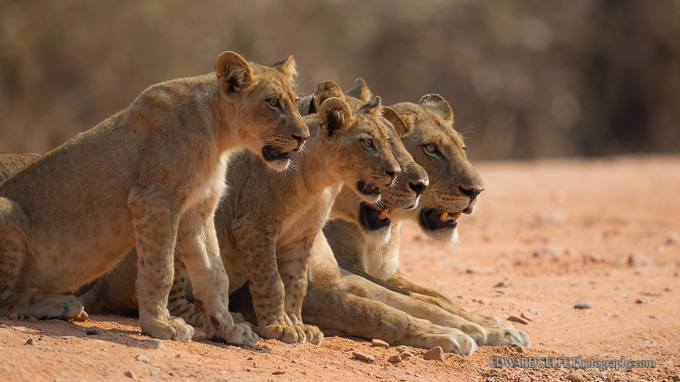
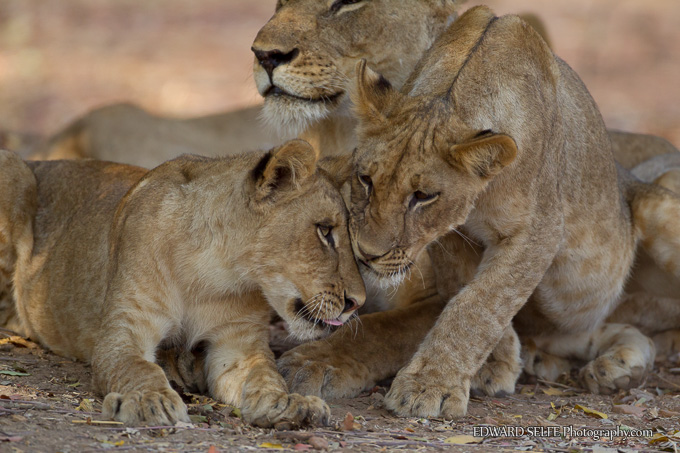
Day 2 follows tomorrow lunchtime!
******************************************************
Day 2:
In the afternoon of that day, we went to see what the lions were up to and found that they had killed a buffalo that was stuck in the mud at the side of a lagoon.
We couldn’t see the site of the kill because it was behind a bluff, but we watched as the lions came and lay on top of the bank to enjoy the little breeze.
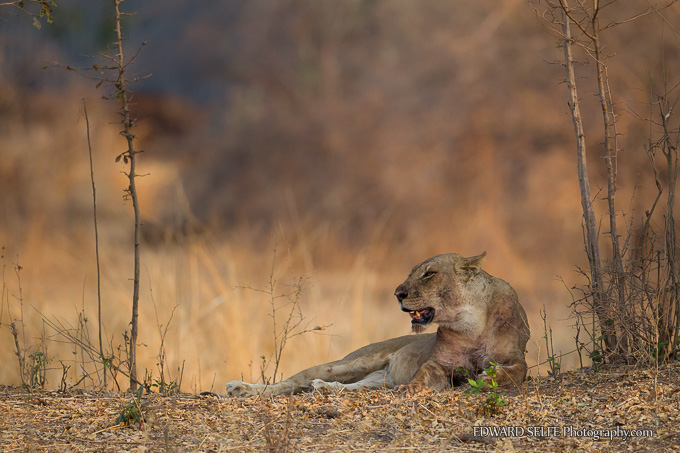
Nearby, in the water, Jacanas continued to feed as if nothing had changed.
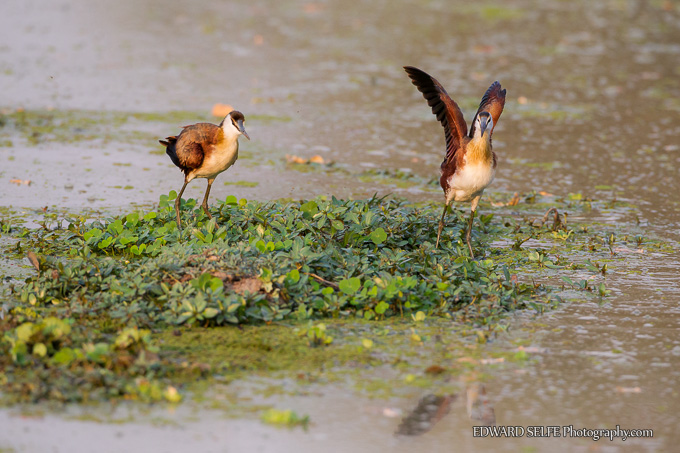
And a Fish-Eagle watched, hoping to pick up some scraps.
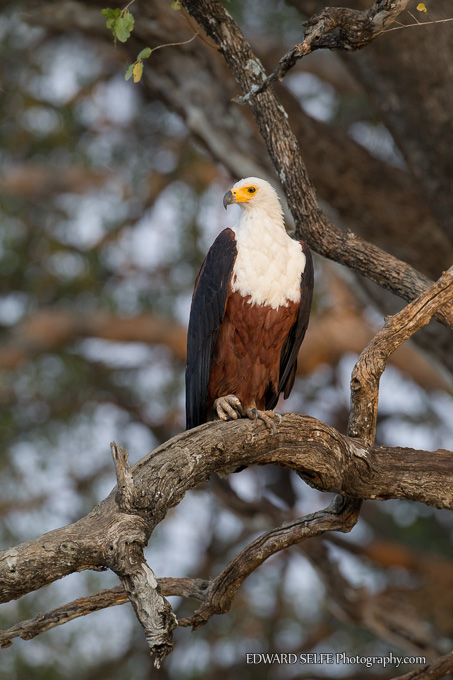
But as the light began to drop, crocodiles started to emerge from the water and head towards the carcass. The lions were having none of it though, and repelled the crocodile with a series of swipes and growls.
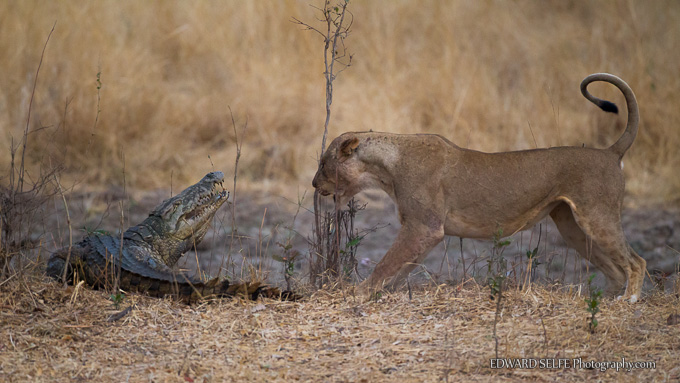
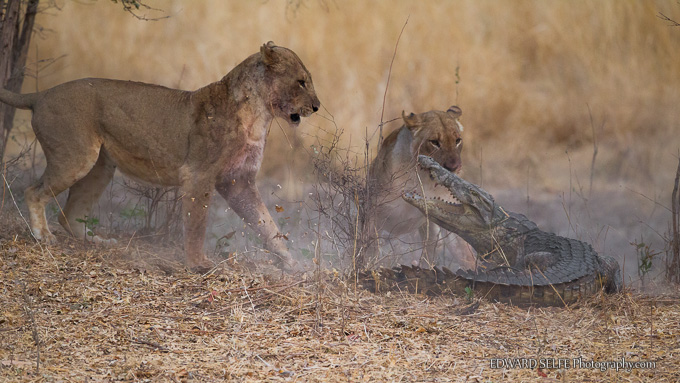
After a long day, we headed back to camp.
OVERNIGHT AT FLATDOGS CAMP
We returned to the site of the lion vs crocodile situation in the morning, and found that the lions were still feeding.
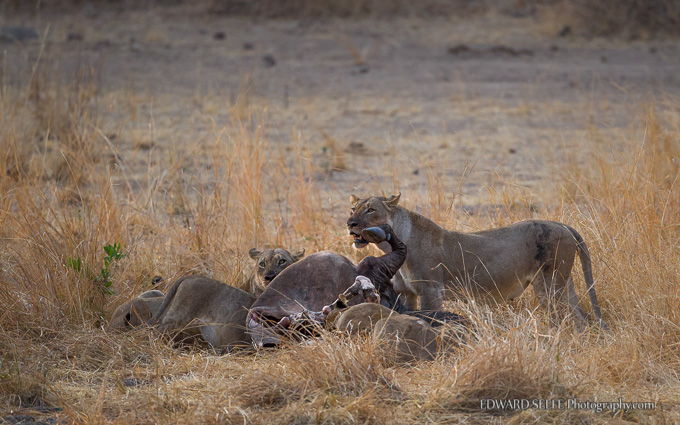
The vultures were waiting patiently but there were no hyaenas suggesting that the lions had defended their meal in the night and the scavengers had moved off.
Leaving the lions, I saw a herd of elephants crossing a plain so we drove around to get the light on the correct side and waited as they came into view. Passing through the trees, we took some nice shots.
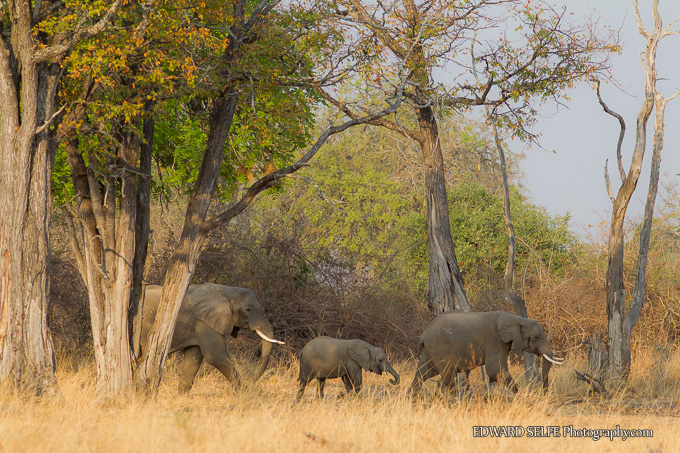
Soon after, we spent some time practicing soft backlighting on a Puku buck who was watching a nearby male approaching his patch.
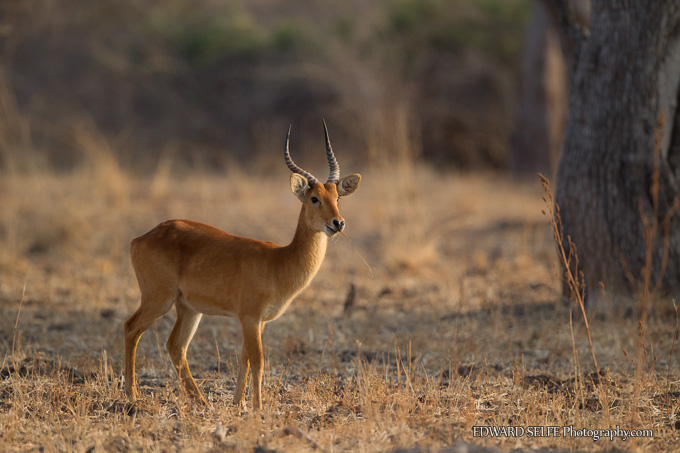
Following that, we drove for some time to catch up with a pride of lions which had killed an elephant the previous evening. We stopped off to photograph a juvenile Blacksmith Plover at a waterhole and then started to see the large numbers of Vultures that we knew would lead us to the kill.
The lions had nearly finished the elephant (only the second time that I have known lions kill an elephant in South Luangwa, although there may well be more occasions before I arrived). We took photos as the older cubs tried to get the remaining scraps from the tough skin.
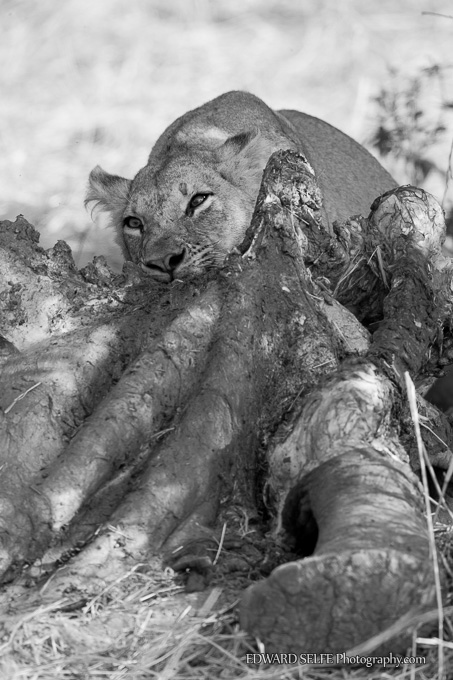
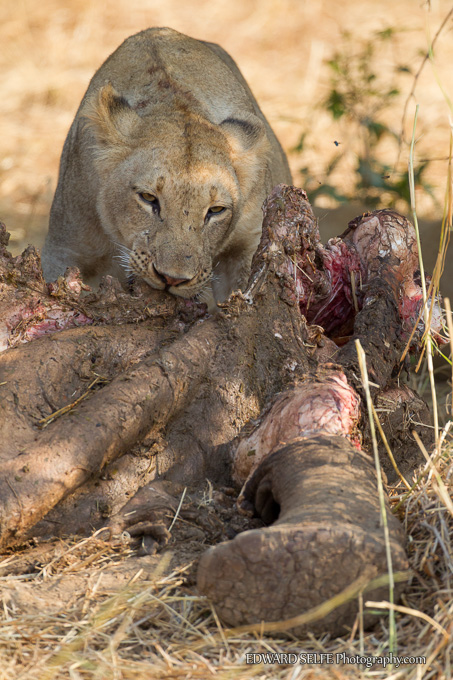
One of the females turned up but wasn’t very welcome!
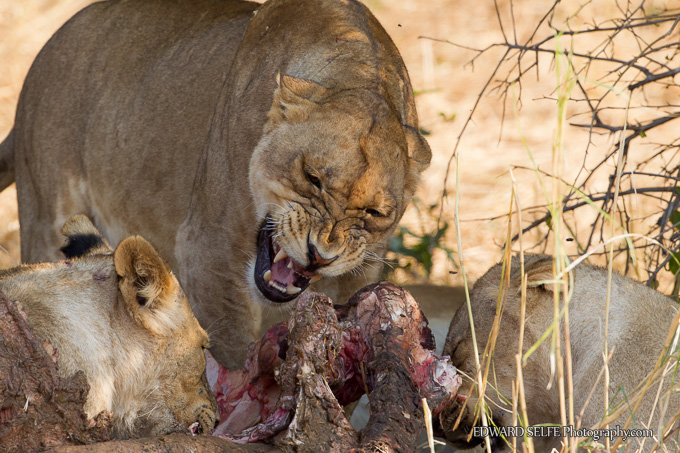
The vultures were waiting nearby but didn’t get a chance because a young male from the pride came down to have his turn.
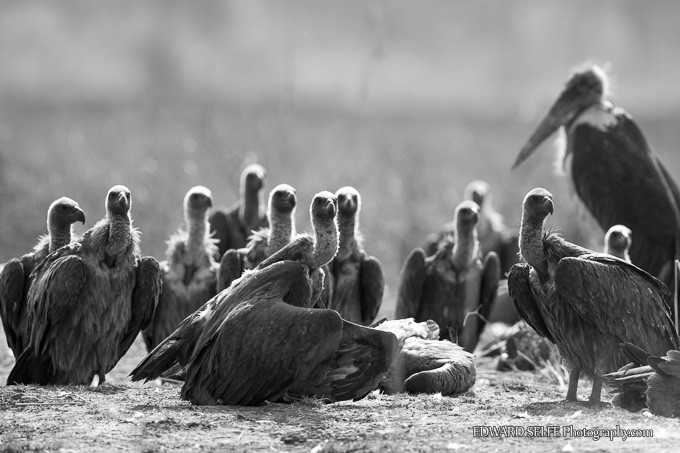
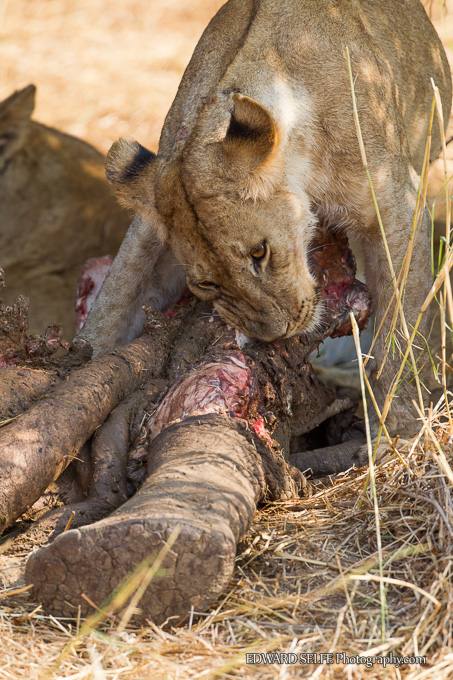
A pride of 17 lions has the capability to kill elephants, but usually they go for buffalo or zebras which are easier. There are prides in Africa that do specialise in killing elephants, however, and I wonder if this pride has developed the technique.
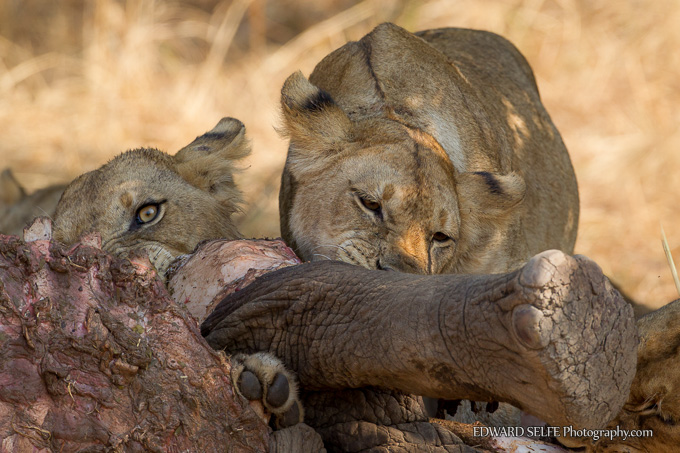
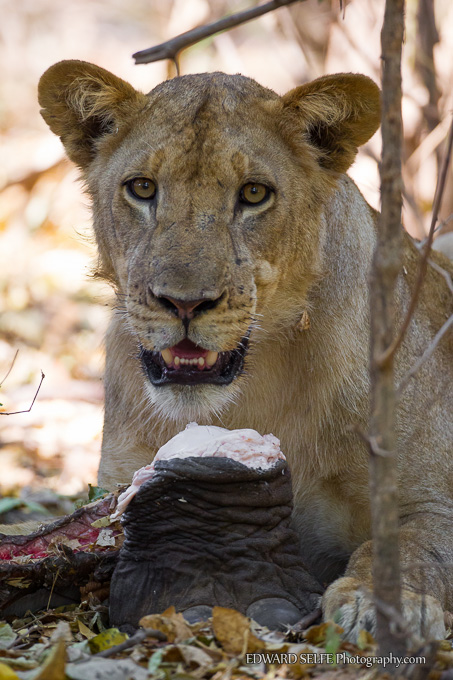
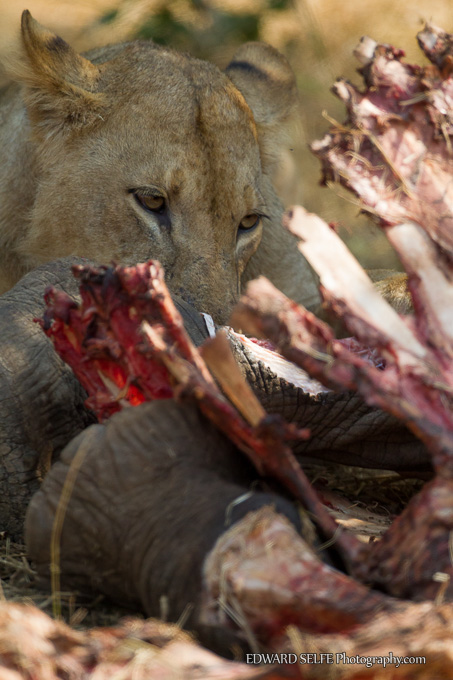
Heading out of the park, we came across a herd of zebras crossing the road. The light was bright but with some some careful use of metering, we could get some portraits.
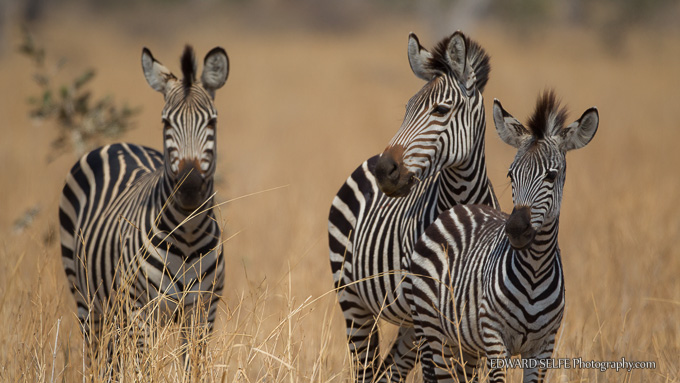
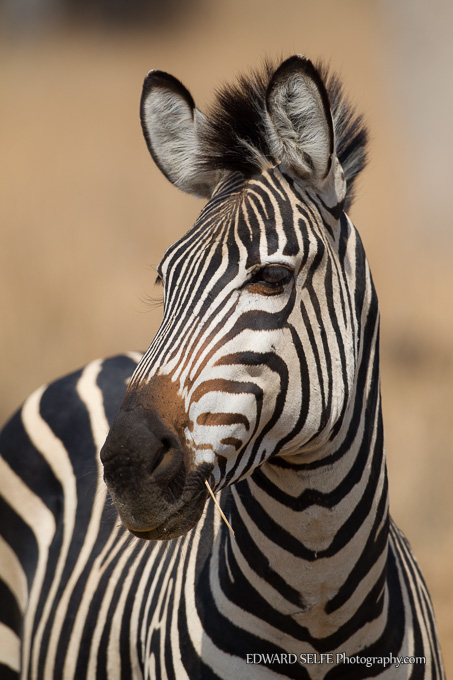
******************************************************
Day 3:
We were joined by Roger and Vicky this afternoon, after their 3-day delayed journey from UK.
We set out and soon came across a bull elephant hoovering up Tamarind leaves near the road. I drove in very close, carefully checking the wind and moving quietly so as not to alarm him. We managed to compose some fun abstract body shots and then he moved away and reached into a tree allowing us to get the whole of him in the frame!
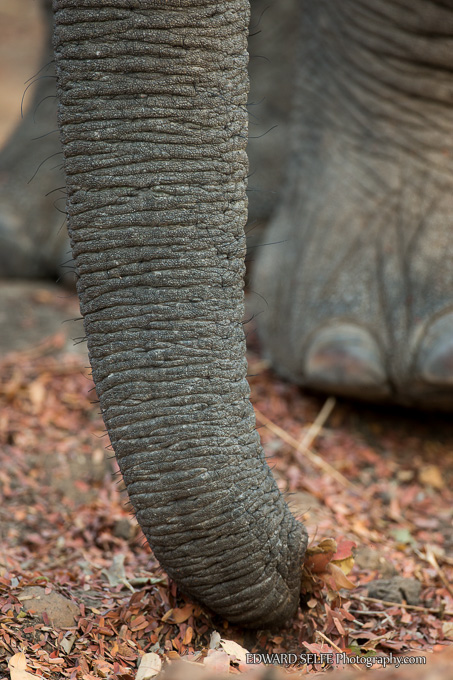
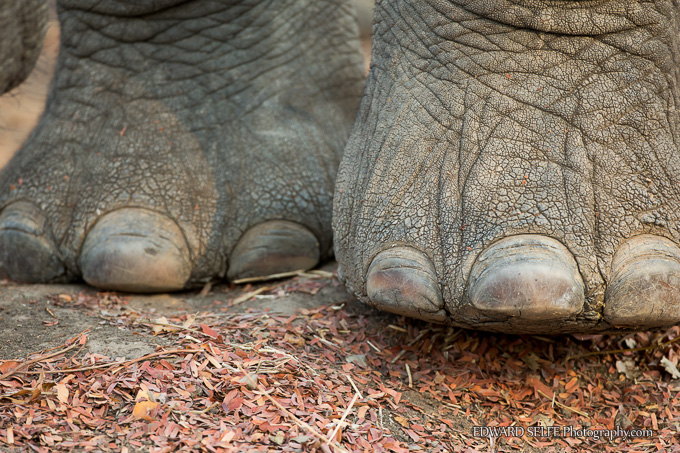
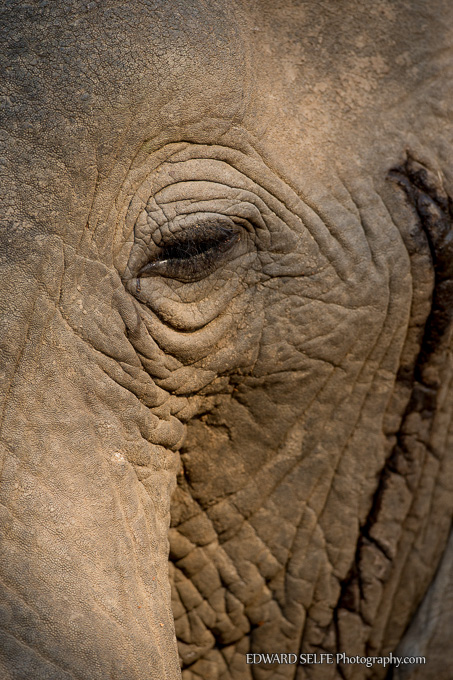
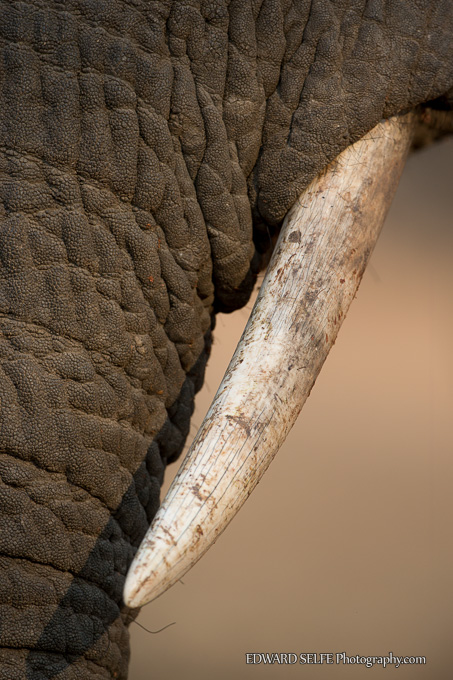
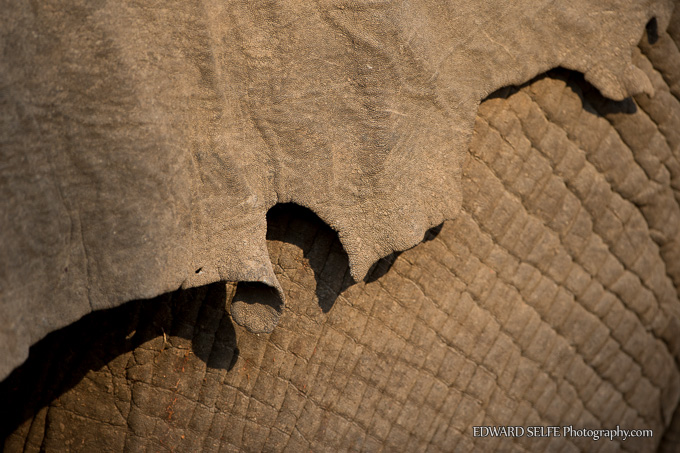
A Fork-tailed Drongo was waiting nearby, swooping down to snatch insects disturbed by the huge animal.
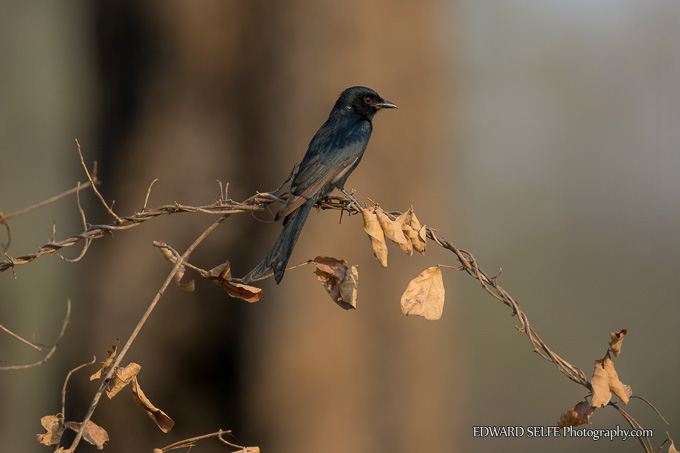
Moving on, we came across a leopard right by the road, who was stalking in the evening light.
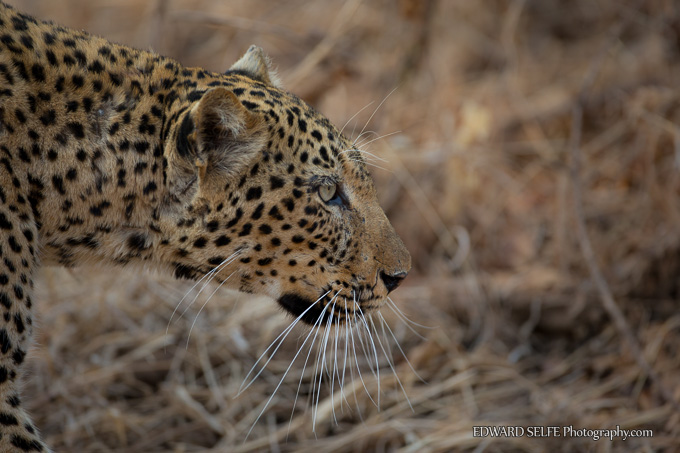
But was always attentive and looked up occasionally when she heard prey nearby.
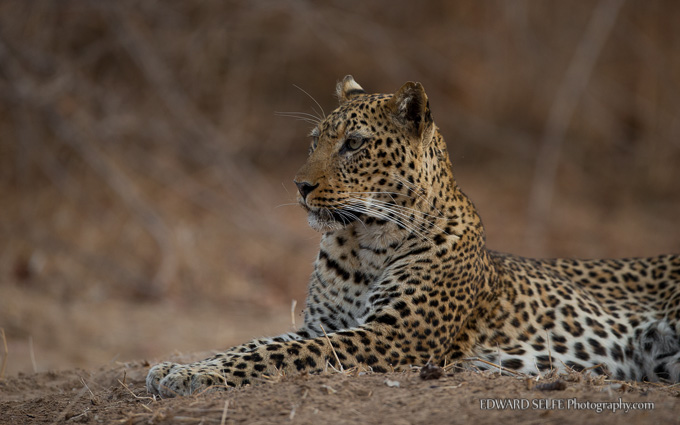
Our night drive was short as we have been having great sightings by day so decided to head to camp early.
OVERNIGHT AT FLATDOGS CAMP
The following morning, we were first out of camp and enjoyed the pink morning light on this giraffe.
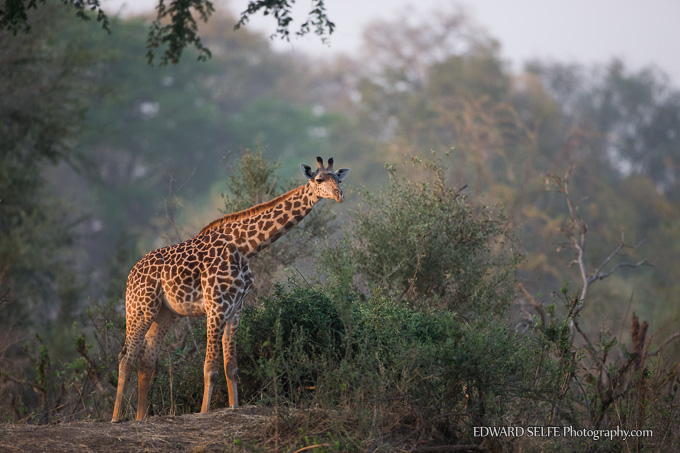
And after entering the park, the first sighting we had was the same leopard from the night before, but this time in a tree waiting for impalas to come underneath.
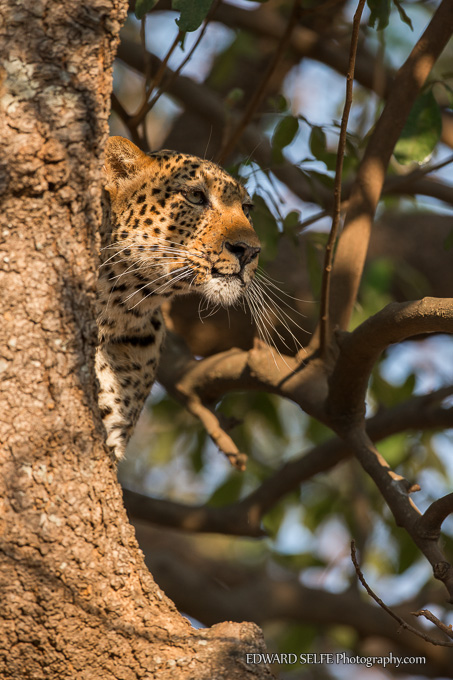
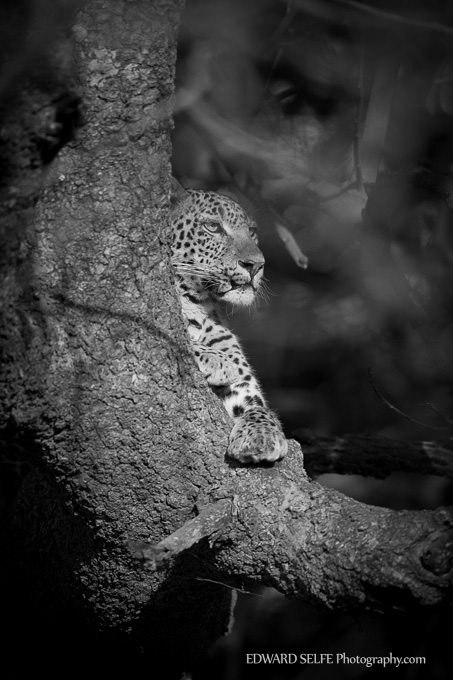
Heading on to a nearby lagoon, we waited for zebras to approach, and photographed them both on their way to water and while they drank.
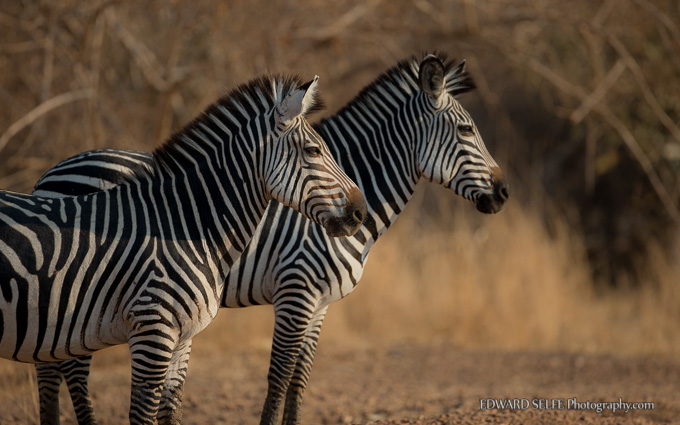
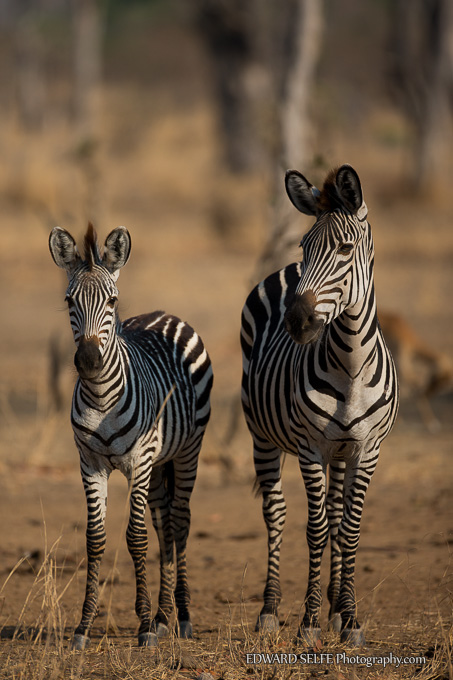
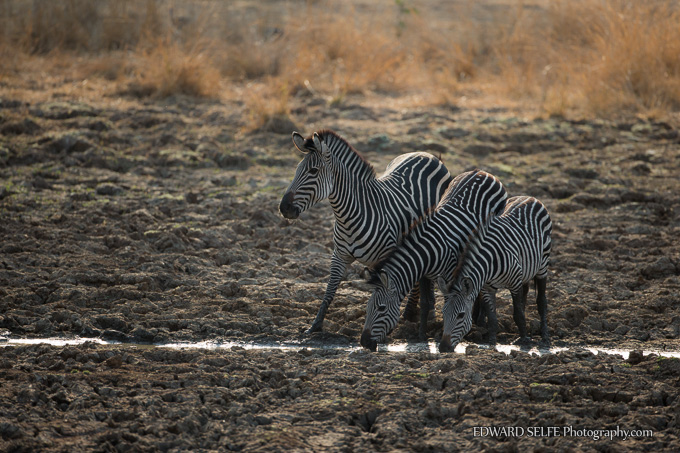
At the next lagoon, a large herd of around 200 buffalo were approaching the water. I guess where they would go and parked in the bottom of an Ebony grove so that we could photo them as they passed.
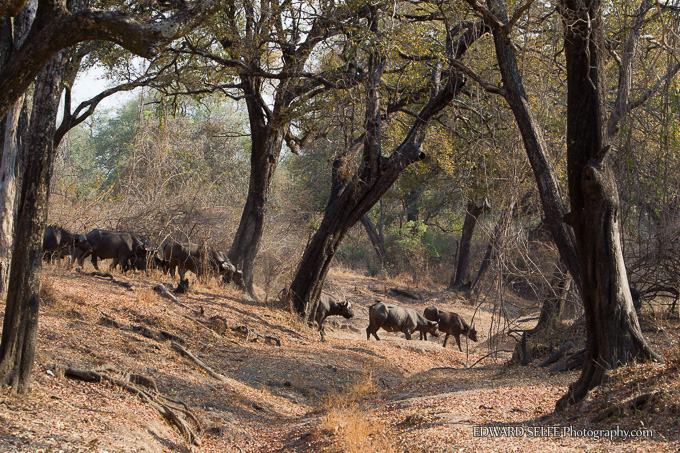
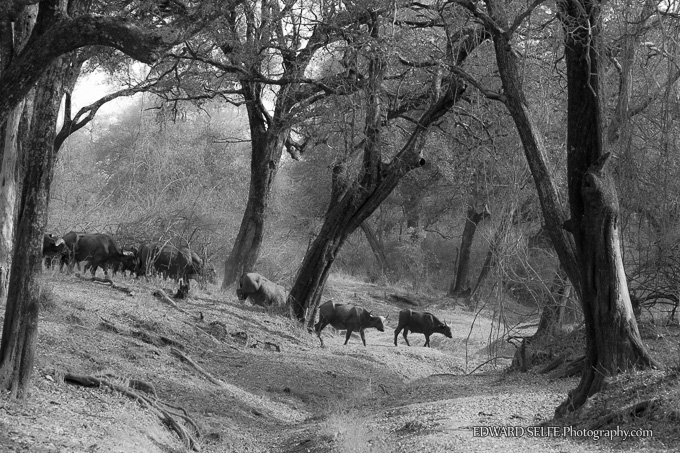
Moving around the other side of the lagoon, we watched as they came in to drink.
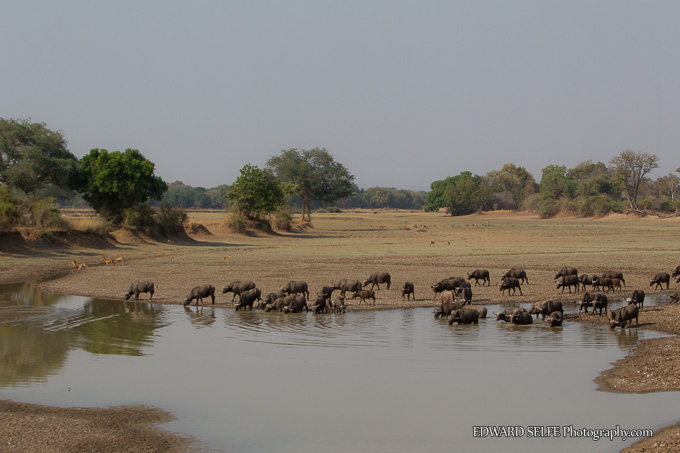
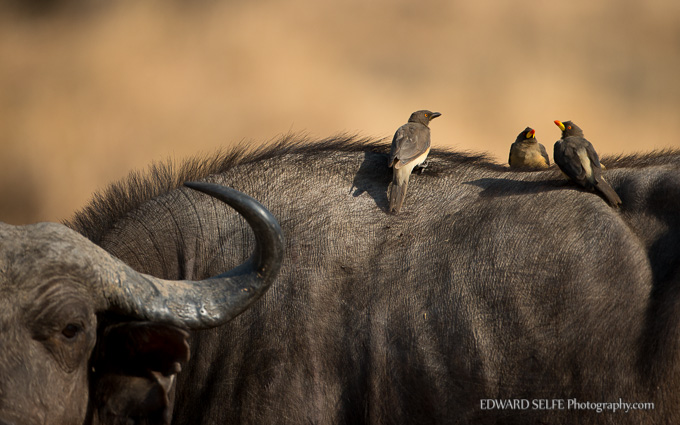
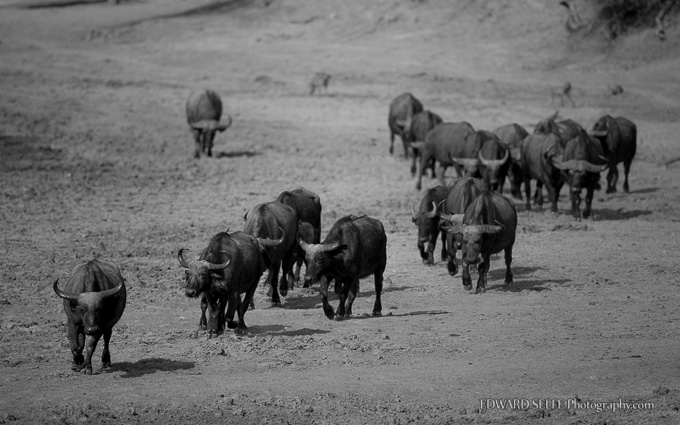
A nearby Saddle-billed Stork gave us more opportunities with a green background to help with offsetting the red and yellow of its bill.
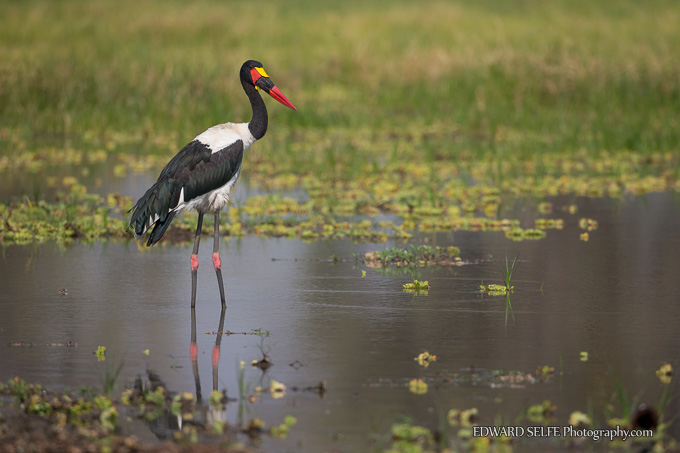
We were on our way to Lion Camp so we had to move on at this stage, but stopped for a large herd of Waterbuck which were heading to water near the camp.
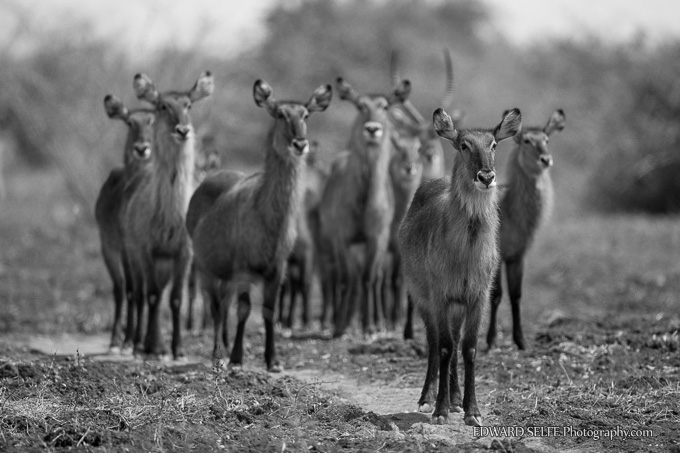
We arrived at Lion Camp, ready to explore the next area of the park in the afternoon.
******************************************************
Day 4:
Our first day at Lion Camp has been excellent, as the area around Lion Camp always is. We started out at 3pm, knowing it would be hot but so that we would be in position to photograph when the light was better. We found a trio of Kudu bulls who took some time to settle as we approached but eventually gave us lots of good chances.
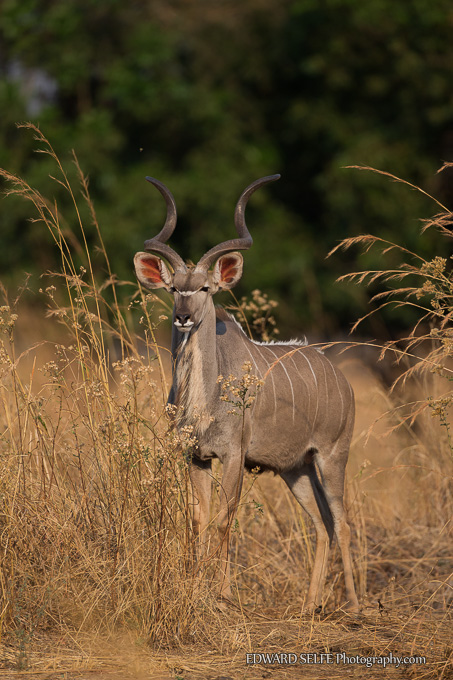
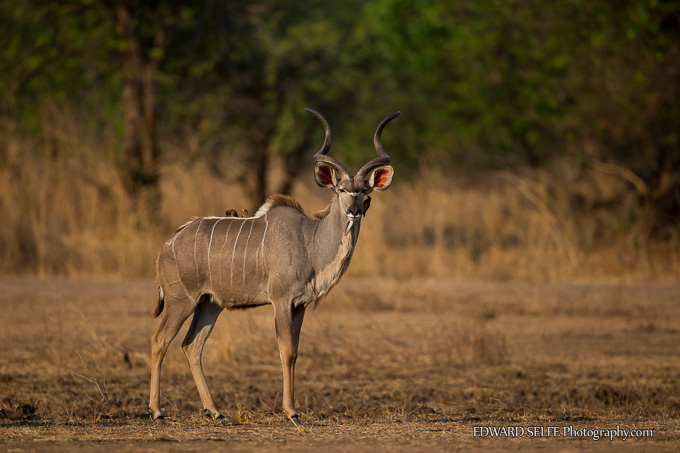
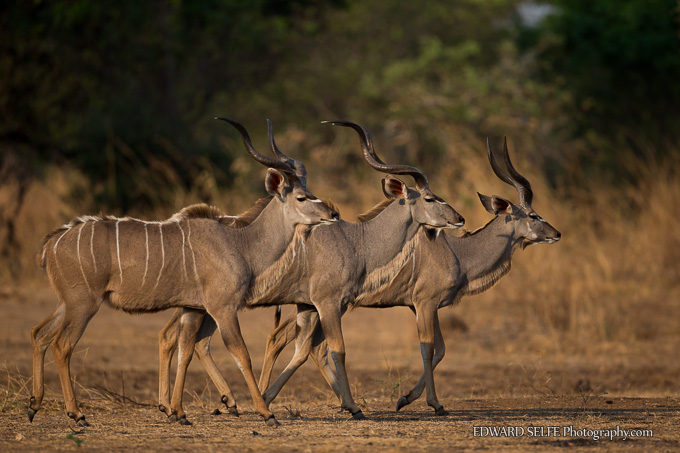
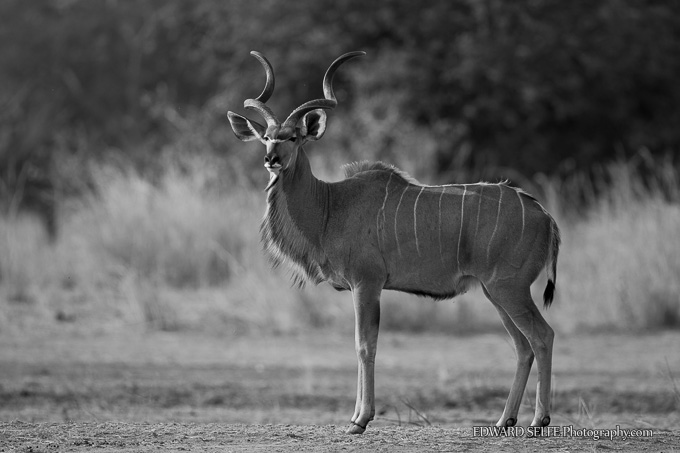
While we were photographing (or trying to photograph) fast-moving bee-eaters, baboons alerted me to something nearby.
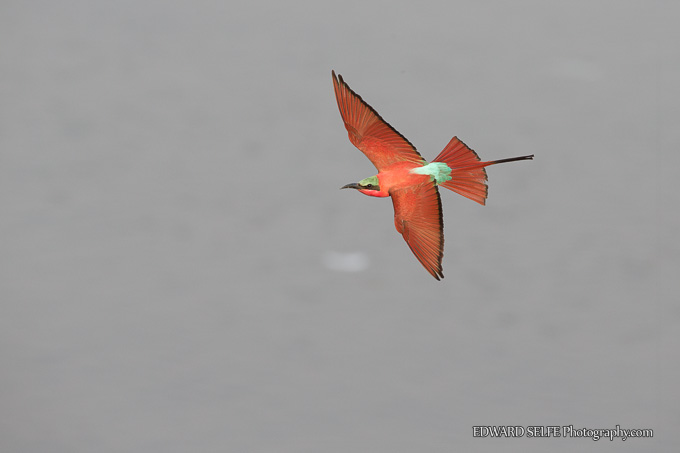
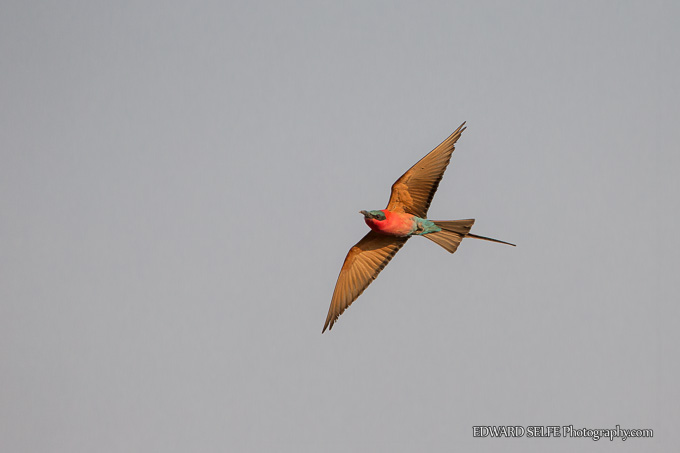
I quickly found a lionness who was returning from the water and led us to the pride’s kill in the long grass nearby.
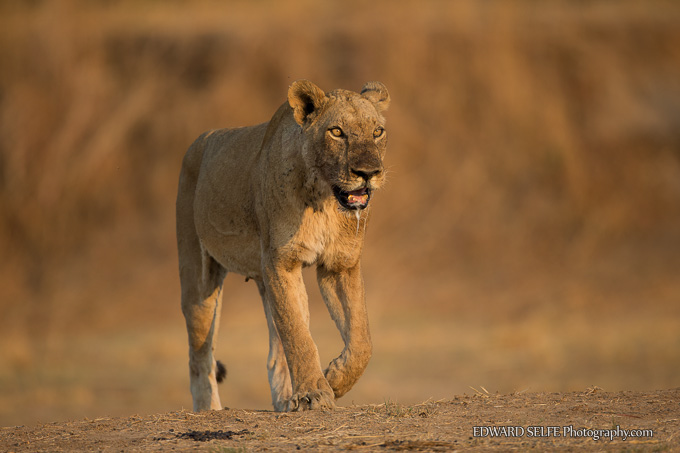
The male was feeding and the rest of the pride was in the long grass.
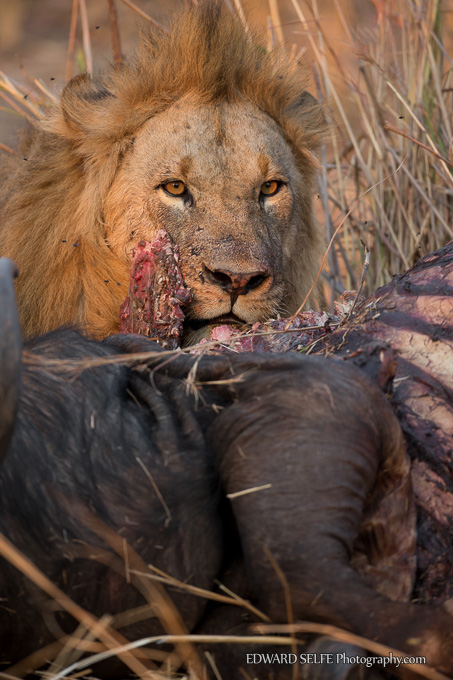
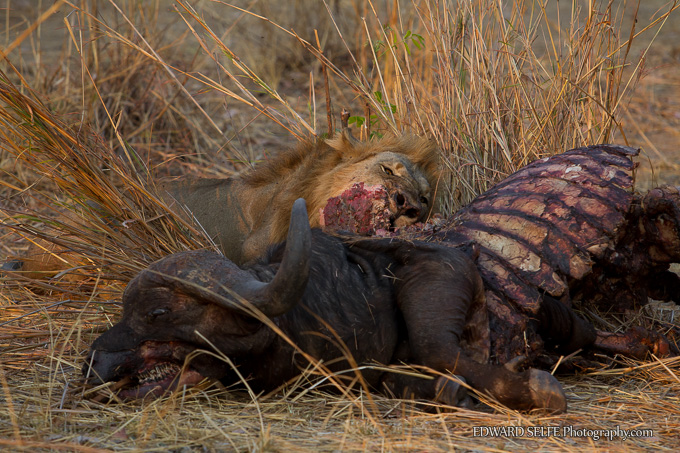
We then spent some time searching for the small cubs of the pride (around 2 months old) and managed a brief glimpse of them, before their mother took them into the bush.
OVERNIGHT AT LION CAMP
Setting out early, we returned to the bee-eater colony where thousands of Carmine bee-eaters are nesting in the river bank. It’s never easy taking shots of such fast-moving birds, but we managed a few good ones each.
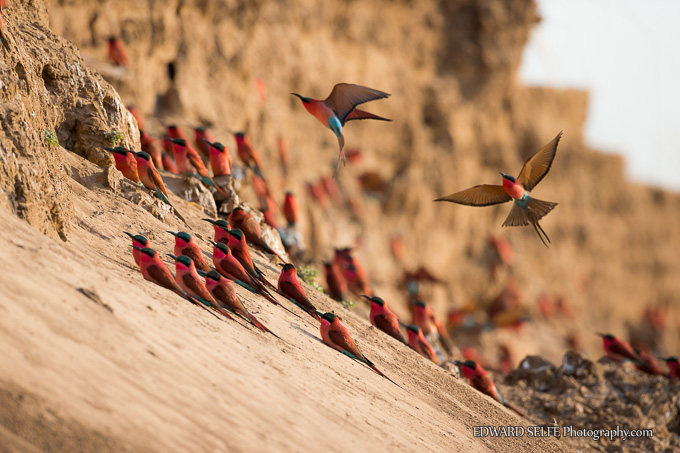
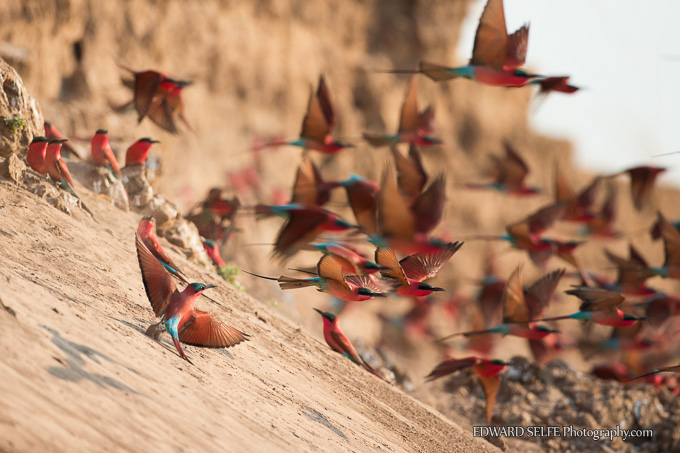
We then went in search of the lions and quickly found all the cubs lying along the river edge. One got up to drink, while the rest remained pancake-lions!
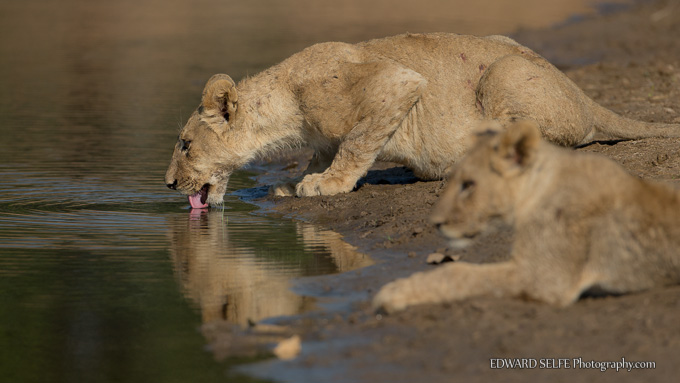
Returning to the site of the kill, we spotted a female in the bush and she had her little cubs with her! We approached very carefully and took some shots of the 2 month old cubs while their mother lay quietly nearby.
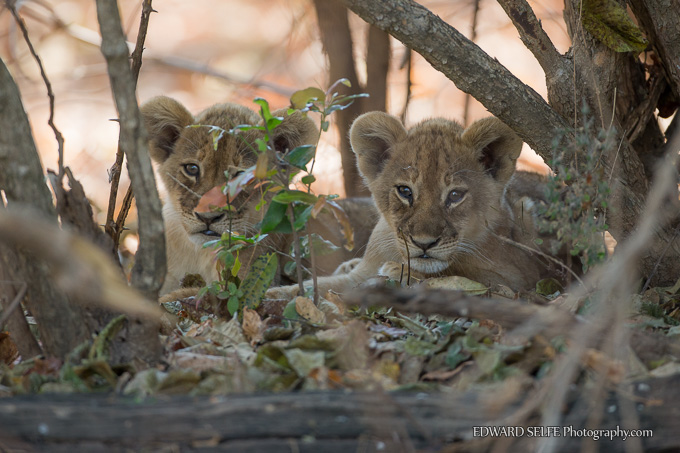
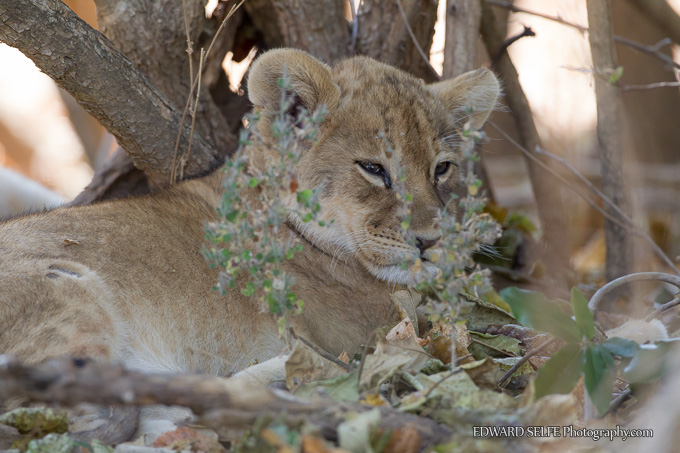
Finally, it was the turn of some static Carmine bee-eaters….an easier challenge!
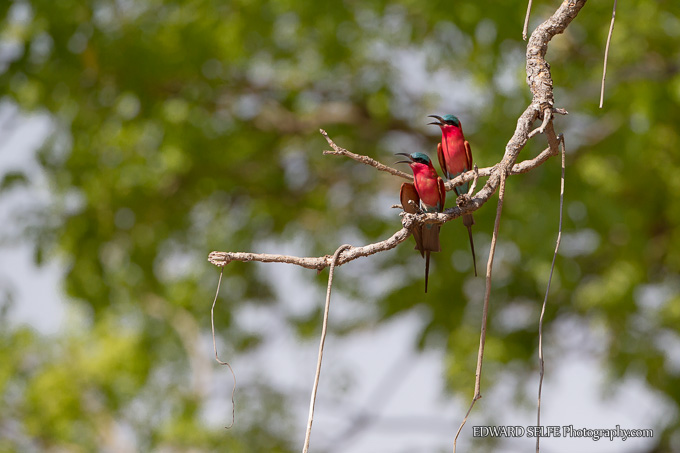
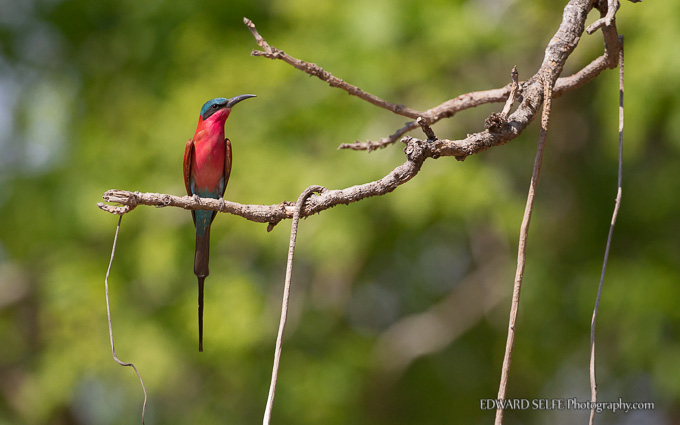
We head out for our 2nd afternoon at Lion Camp in around 15 minutes!
******************************************************
Day 5:
Following our successes in the morning, we set out with high hopes for the afternoon, and it turned out to be one of our best safaris so far. Our plan was to visit a carmine bee-eater colony which would be lit by the afternoon sun, and then move on into an area filled with Sausage and Acacia trees, which becomes a hunting ground for leopard after dark.
On the way to the colony, we found giant flocks of Red-billed Queleas, swarming like locusts, and a herd of Kudu resting in the shade under a tree out on the open plains.
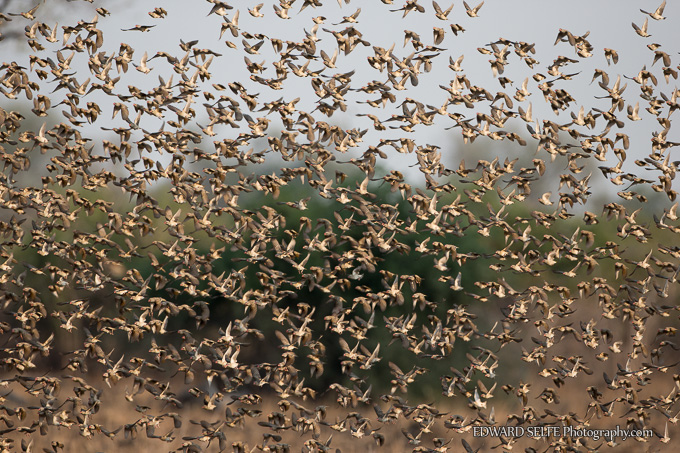
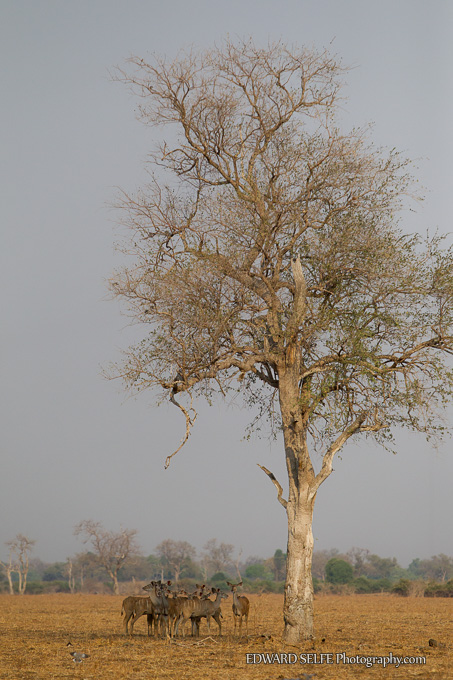
And near the colony, we were distracted by hippos fighting nearby. The fight never came to much, but the splashing water and grunting sounds were most entertaining.
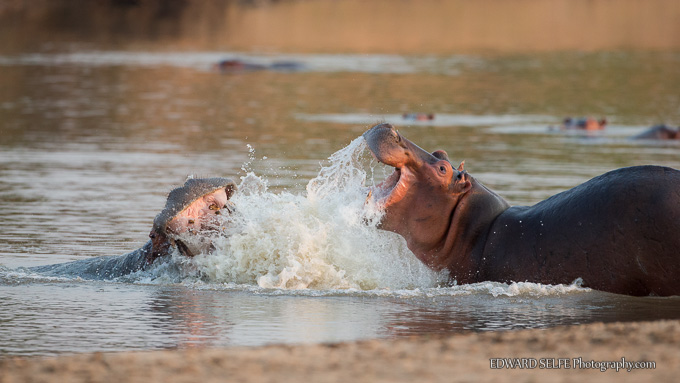
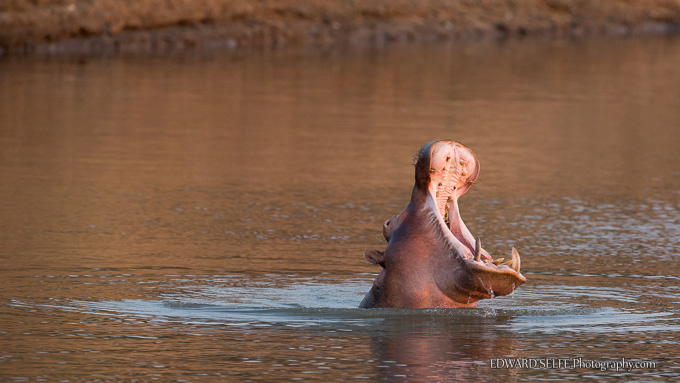
Returning to the bee-eater colony, I enjoyed trying to make a nice composition with the incoming Carmine bee-eaters, and the outgoing White-fronted (Green) bee-eaters whose holes have been taken over. The light was fading and they refused to sit still(!) but I managed a few shots.
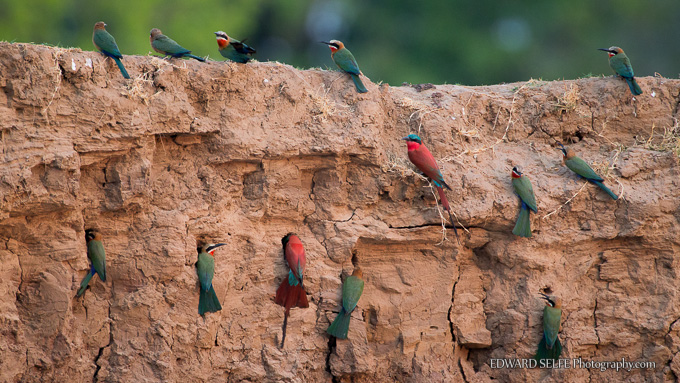
Moving on after dark, we drove through some excellent leopard habitat, and finding very little game, I suspected that the spotty cat was on the prowl. We found a large male soon after, who meandered through the grass and out of sight. We manoeuvred into a position where we might see him again, and were rewarded when he came out and sat at the base of the tree. He kept looking up into the branches, and I immediately thought that he had stashed a carcass up there. We searched but couldn’t see anything with the spotlight. I guessed he perhaps wanted to climb the tree to rest or to spot for prey so we waited. After some time, he scaled the tree with ease, and retrieved a baboon carcass that he had hidden in the first fork, where none of us could see it. He continued to feed and we used two spotlights to try to reduce the shadows of the branches.
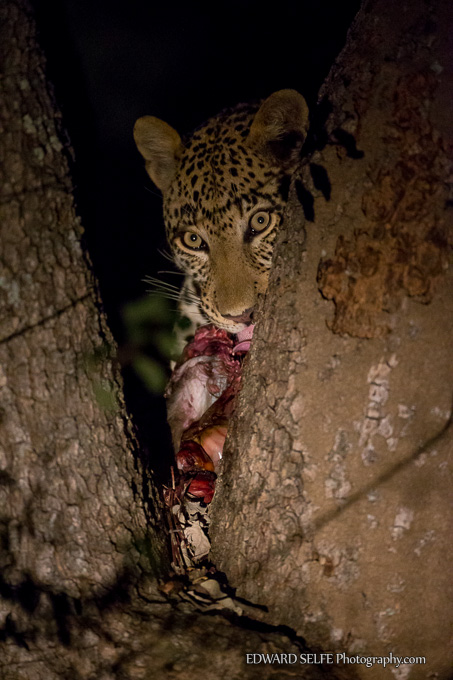
We stayed with him for a long time, and then headed back to camp. On the way, we found another leopard who had just killed an impala and was out in the open, cleaning her paws. We talked about how to use another vehicle’s spotlight to get a nice side-lit effect.
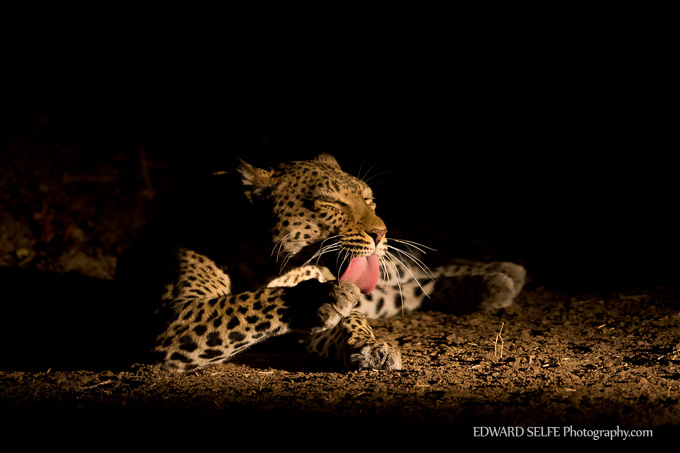
OVERNIGHT AT LION CAMP
The following morning, we set out to find one or both of the leopards we had seen the previous night, but in the end found neither! It’s never a good idea to have a plan in the bush! So we settled for some time with baboons, impalas, pukus, lilac-breasted rollers, and in the beautiful Ebony forests south of Lion Camp.
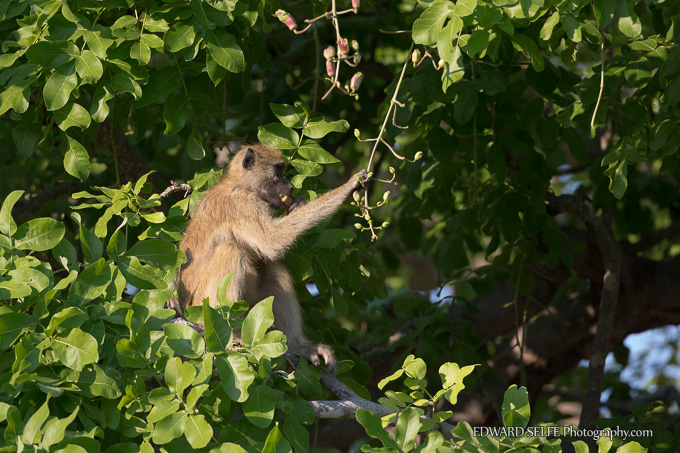
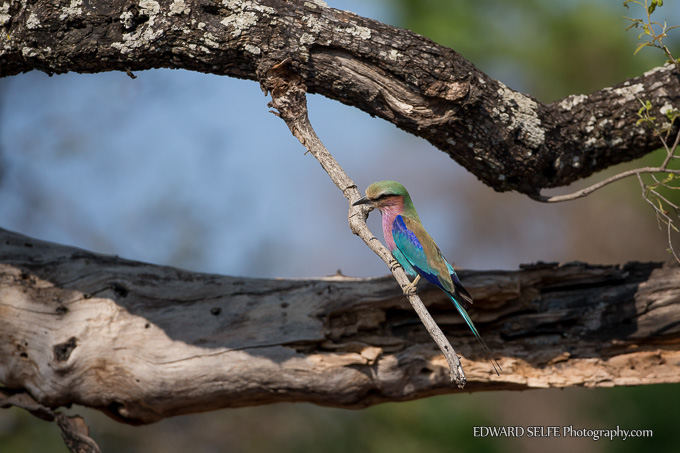
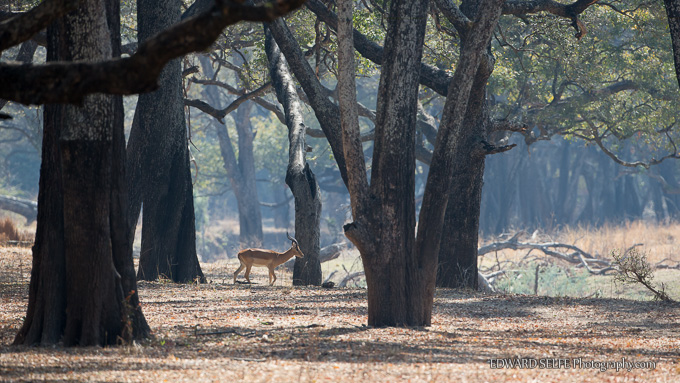
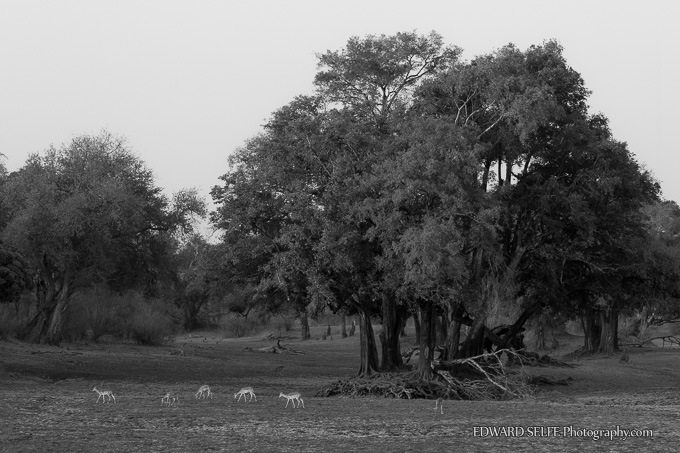
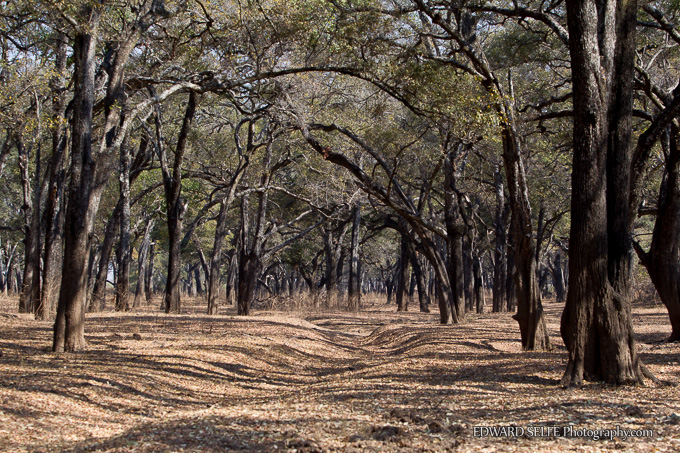
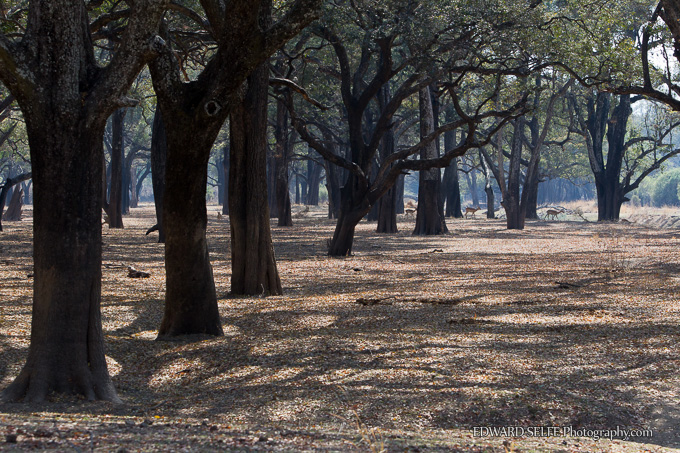
Heading back to camp for brunch, we found a Martial Eagle right on the roadside, standing guard over a freshly killed Guinea Fowl. It tried to take off and carry the prey to a tree but couldn’t get airborne so we enjoyed watching as it guarded the carcass from scavengers. We left after a while so that the eagle could feed without any distractions or unwelcome guests.
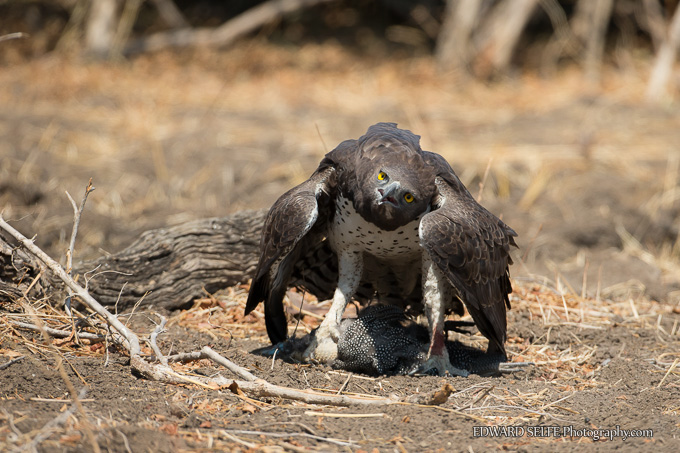
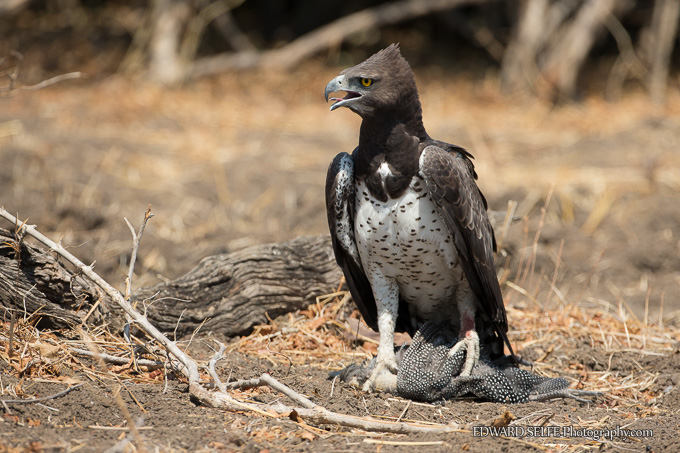
******************************************************
Day 6:
We set out early again for our last afternoon, and quickly found a herd of zebra. They never arranged themselves in a pleasing way, and even though we waited a while, I didn’t hear many camera clicks from behind me! Then two of the stallions in a nearby group decided to make silly faces at each other, in an attempt to impress the mare nearby!!
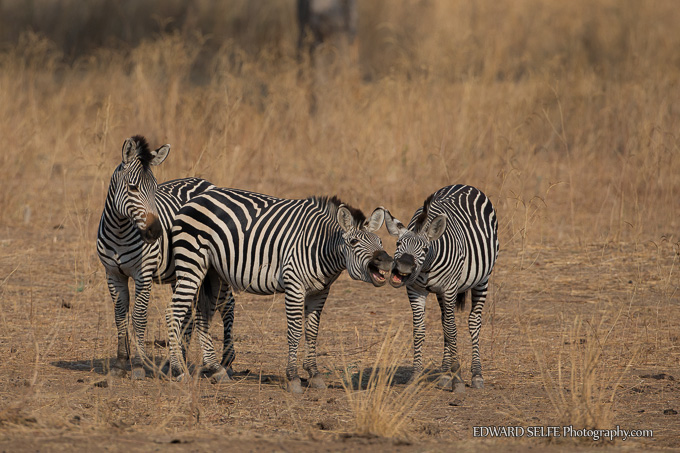
As the herd walked away, we did manage some better shots, discussing different ways of composing the image. Being able to share ideas such as this is one of the great benefits of a photo safari, and I am always careful to give advice and technical suggestions, but not to tell people how to compose or what to include/cut out, as that is for photographers to decide for themselves.
We decided to head down to the river and try our luck with a large group of hippos resting up in the shallow water. It was a good decision as the hippos were very restless and compressed into a small space. Tempers were close to the surface and our arrival prompted some displays of dominance from large bull hippos!
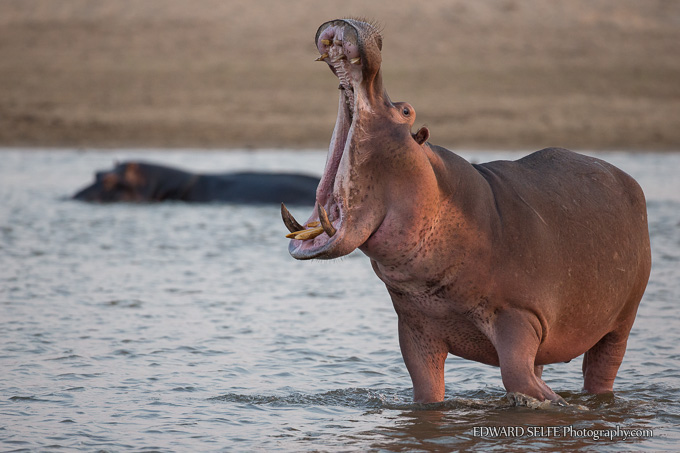
We kept back from the water’s edge and enjoyed the show as the light faded. In the last 20 minutes before dark, millions of Queleas began to come to the water to drink, arriving in endless streams, drinking and then moving off without breaking the chain. For 30 minutes, a long snake of tiny birds passed us, thousands every second, in an astonishing natural phenomenon. It’s hard to capture this on stills camera, and instead we decided to have a drink and just watch.
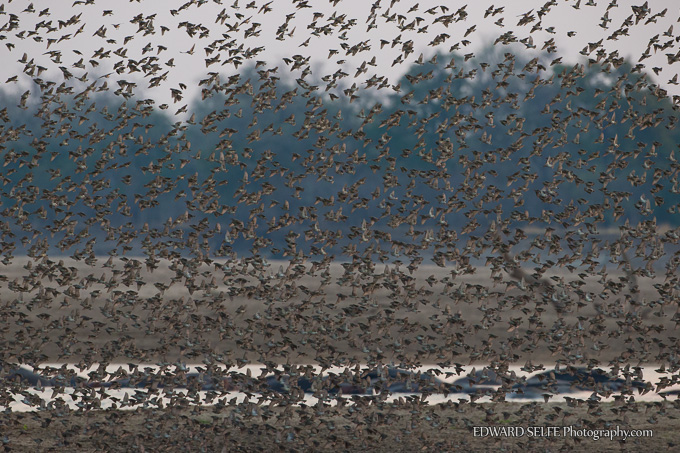
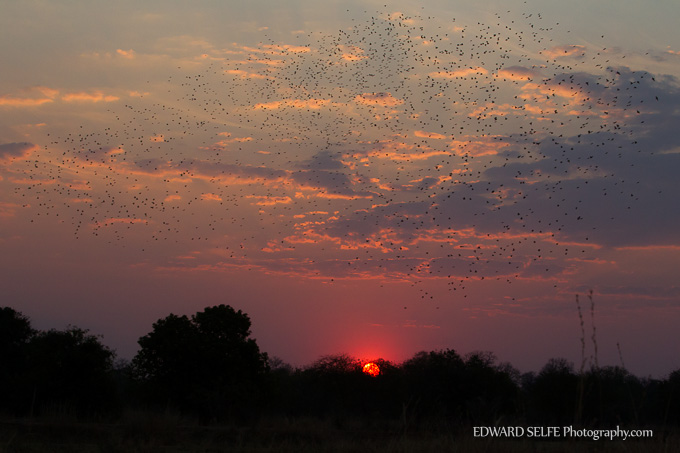
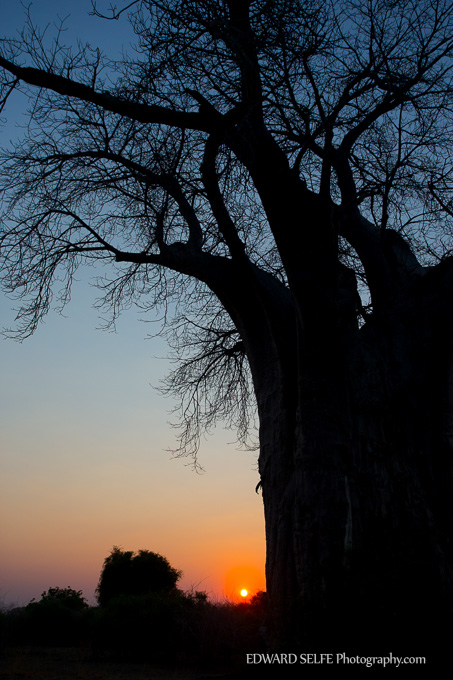
OVERNIGHT AT LION CAMP
Our last morning at Lion Camp was probably our best. We set out early in search of the Hollywood pride who we hadn’t seen for 24 hours. I tracked them down using some monkey chatter and the rattling calls of indignant Guinea fowl and we enjoyed 2 hours of lions playing and socialising in the morning sunshine.
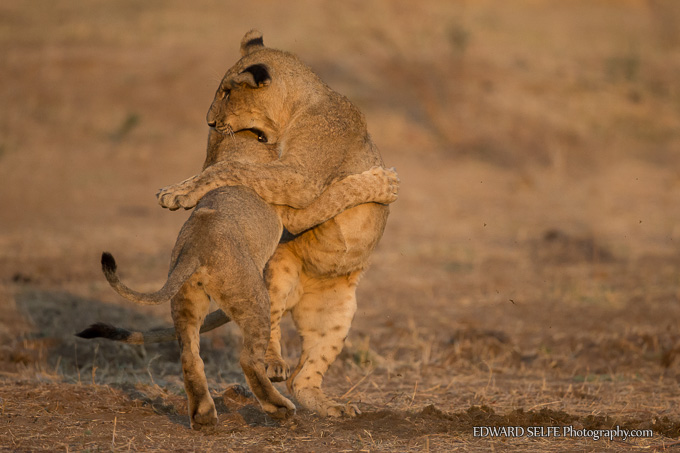
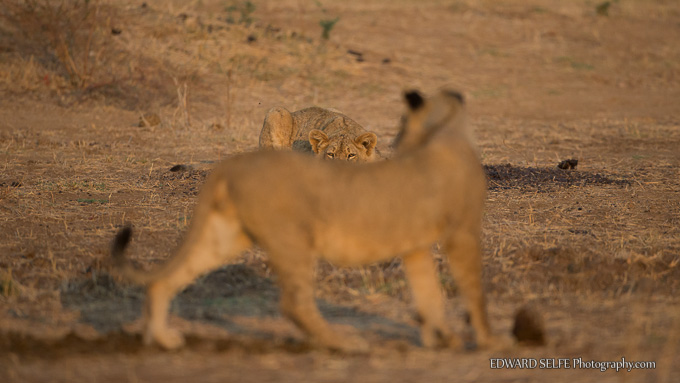
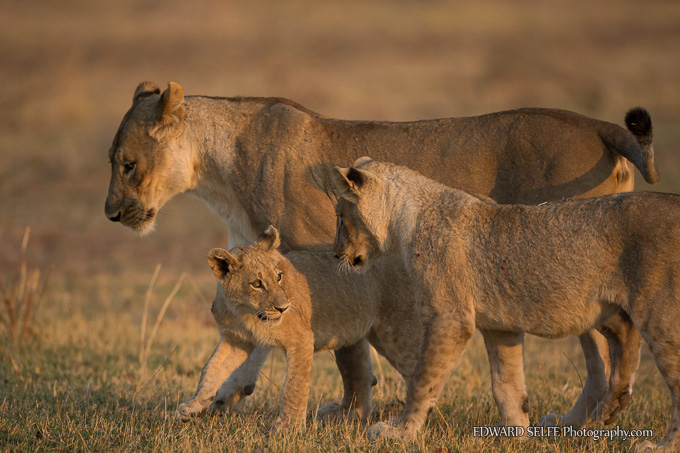
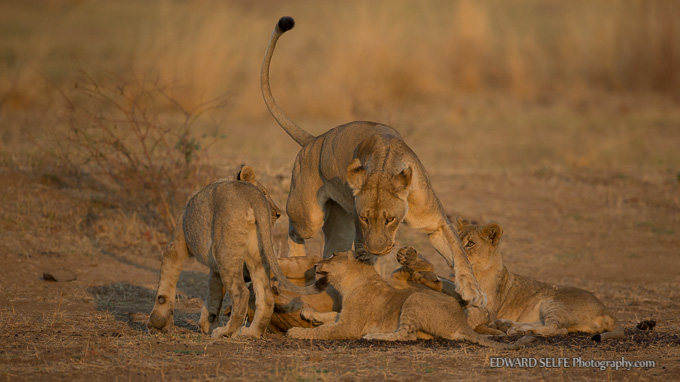
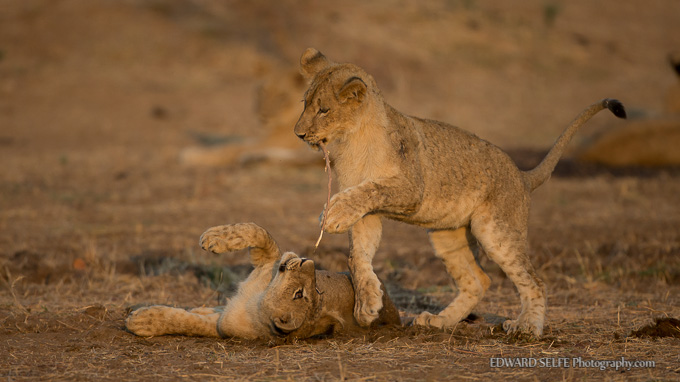
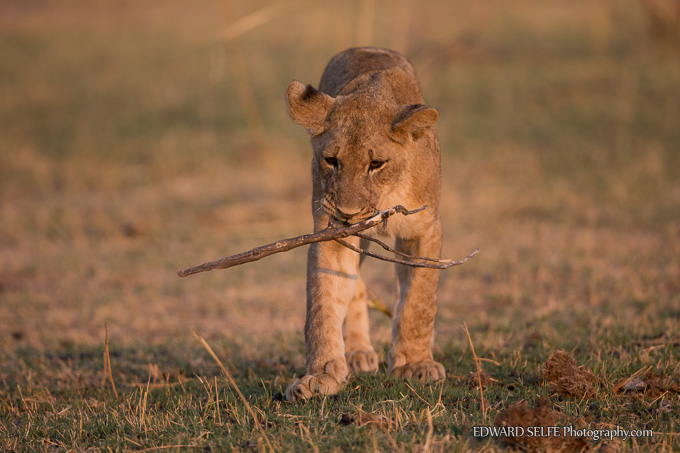
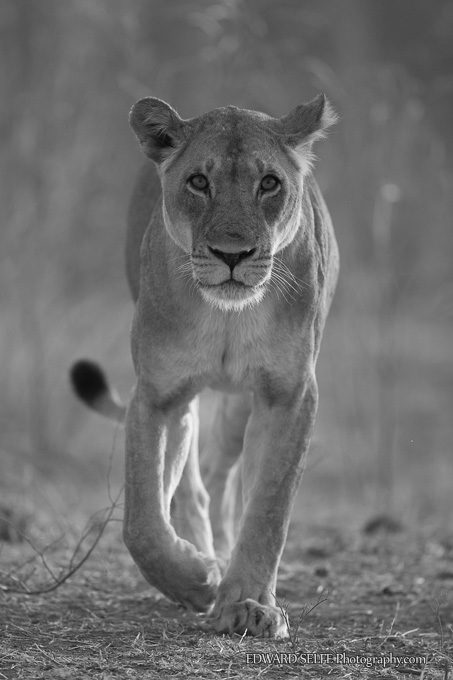
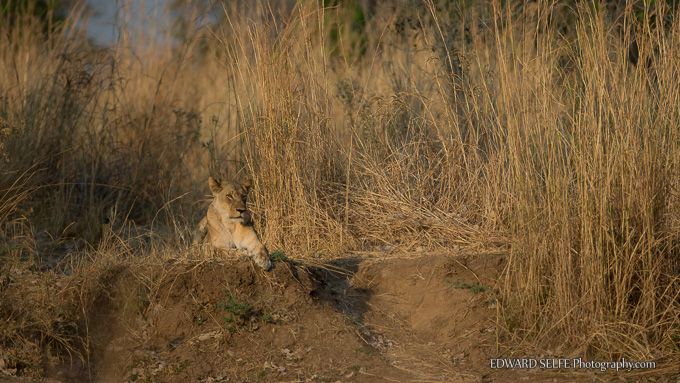
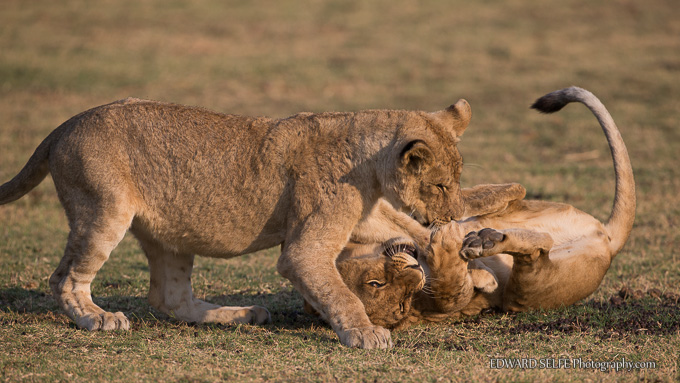
The male was nearby but barely lifted his head to greet us, so tired from his nightly wanderings and endless territorial calling.
Soon enough, impalas located the pride and started snorting from afar.
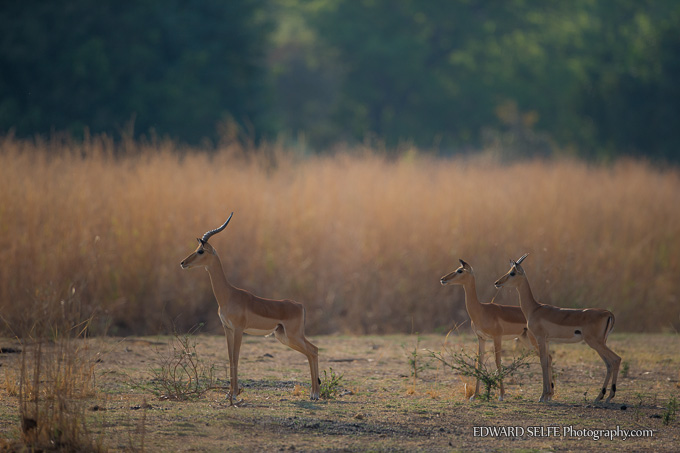
******************************************************
Day 7:
Arriving at Zikomo Safaris, in the Nsefu Sector of the South Luangwa, we were treated to high tea, before our afternoon safari. We left when it was still hot, in search of game in the dry lagoon system just behind the camp. We took a lot of time trying to track down a herd of Eland, but they were accompanied by a very shy bull who kept running whenever we came into view, taking the herd with him, so we soon gave up on that plan.
There was a small amount of water in the bottom of one of the dry channels and a hippo emerged as we drove up. He wasn’t in a hurry and shambled off down the gully, giving us time to compose a shot with the pathway in front and behind.
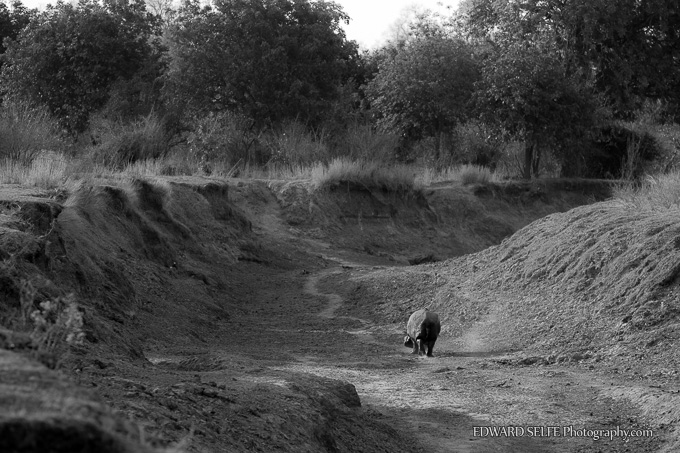
Knowing that game would be coming to drink in the late evening, we moved on to Lunga lagoon, a large (but mostly dry) lagoon north of Zikomo. We found elephants on the way there who were too close for my lens, so I tried some abstract shots in the soft light.
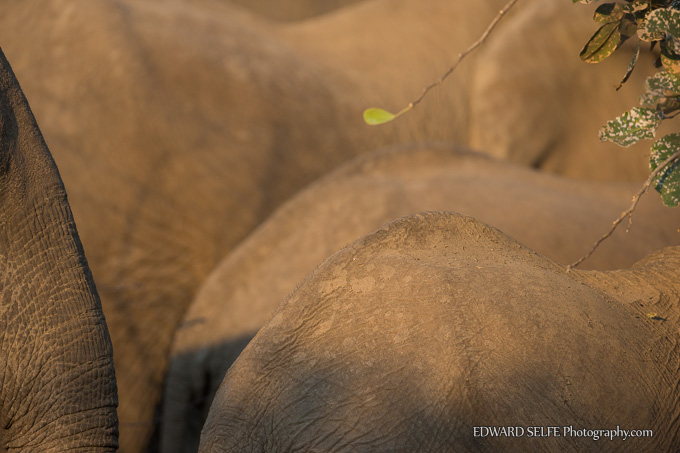
And our arrival at Lunga coincided with drinking time for the resident buffalo herd which appeared on cue and started to come to water. As the sun went down, we tried different compositions and thought about how b&w conversions might look later.
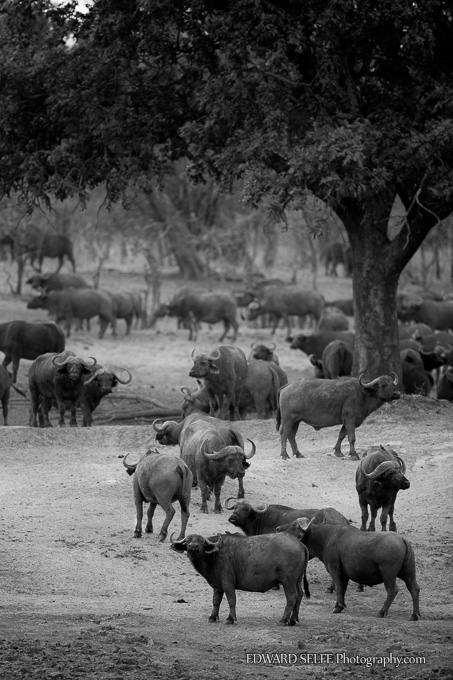
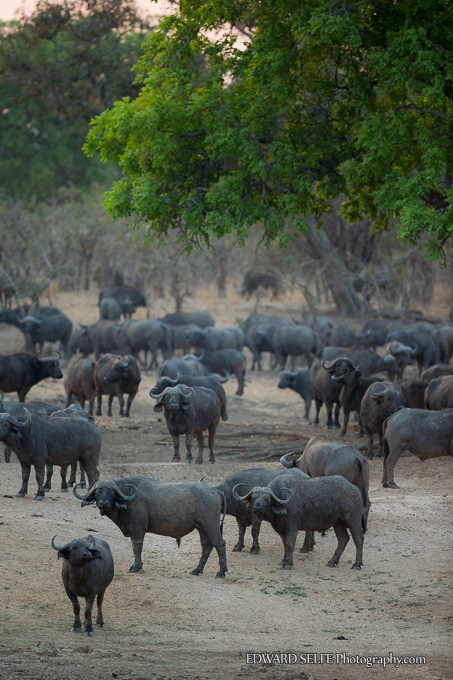
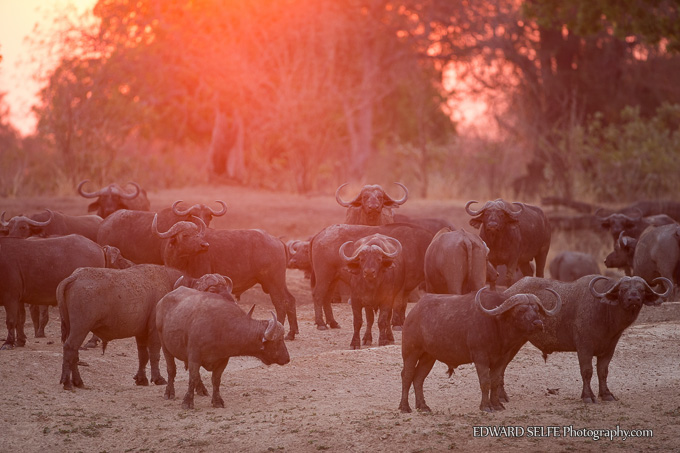
Heading back to camp after sunset (my 2 guests were not so interested in the night-time safari) we found a Large-spotted Genet appearing from a tree-hole.
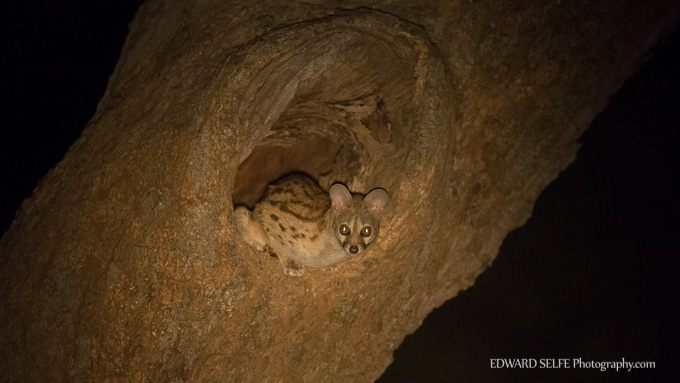
OVERNIGHT AT ZIKOMO SAFARI CAMP
It was hot overnight so we left in t-shirts for the morning safari, knowing that soon enough it would be into the mid-30s! We tracked down the same buffalo herd, which hadn’t gone far…..
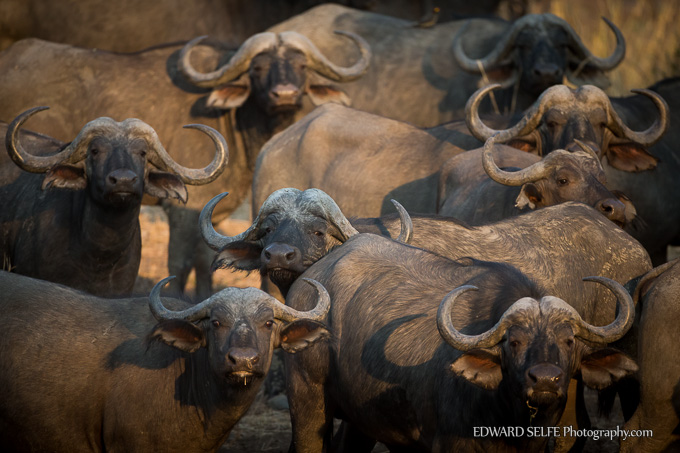
…………and then photographed baboons in a natural cathedral that we found in the forest along the lagoon edge. I learn plenty from my guests on these trips, and looking further into the distance for opportunities with a long lens is one of the ideas that I picked up.
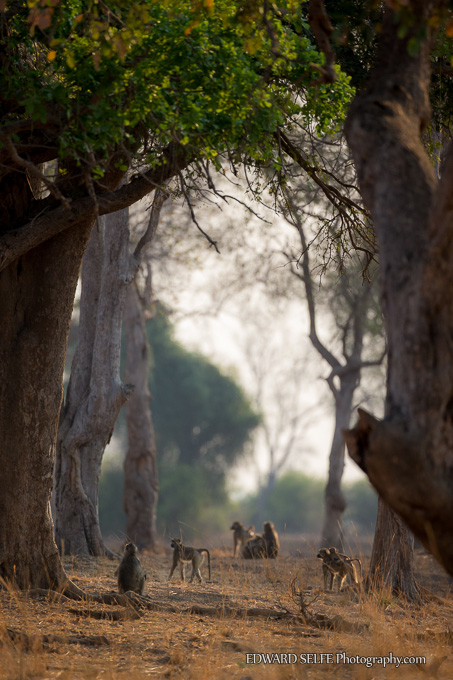
******************************************************
Day 8:
We had a great afternoon safari, heading to a more distant part of the park to look for the resident lion pride there. On the way, I saw an alert impala under a tall tree and saw a chance for a long-range animal-scape.
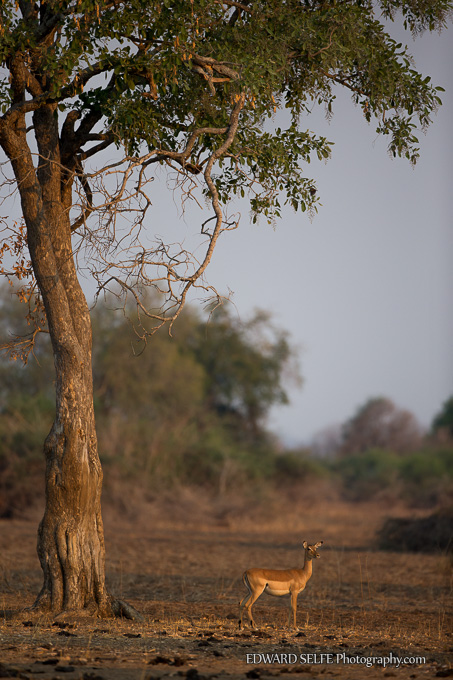
We got to the lions’ favourite hang-out and soon located the females who were resting in the bottom of a sandy channel. One of them soon came up onto the plain and her cub trailed close behind. Moving the vehicle to position ourselves for their greeting, we caught the cub as it rubbed its head against its mother’s and then lay down nearby.
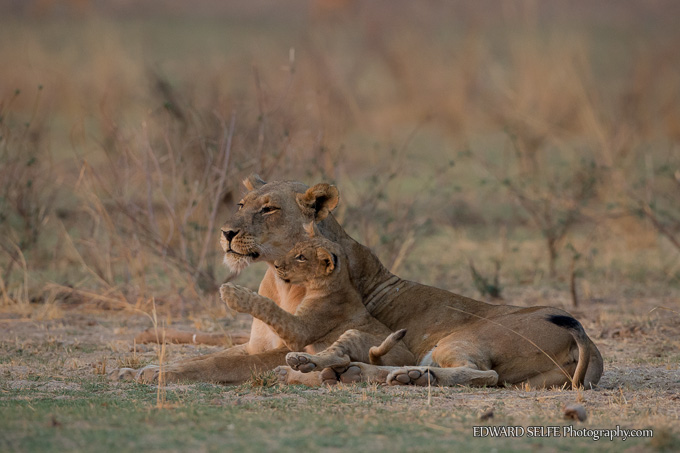
The light fell so we moved off and found a place for a break nearby. As we watched the pride from a distance, a hippo started to approach the lions, apparently unaware of their presence. We weren’t sure what would happen except that the lions didn’t switch into hunting mode, so we guessed that the hippo was a bit too big for 5 adults and a tiny cub to take on! The hippo suddenly got their wind but was too close to flee, so charged towards the lions, scattering them in all directions!
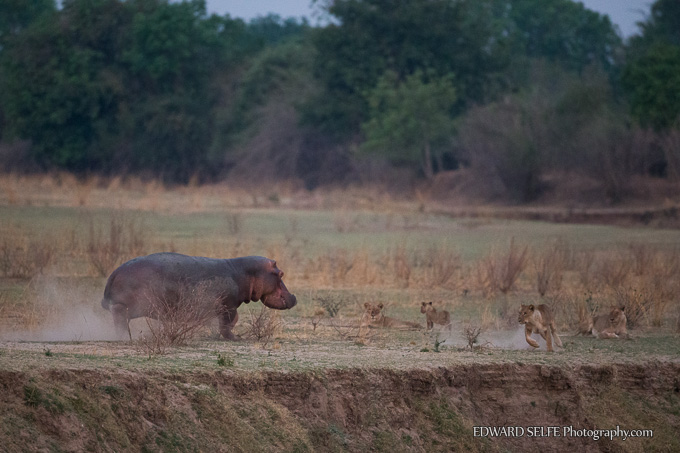
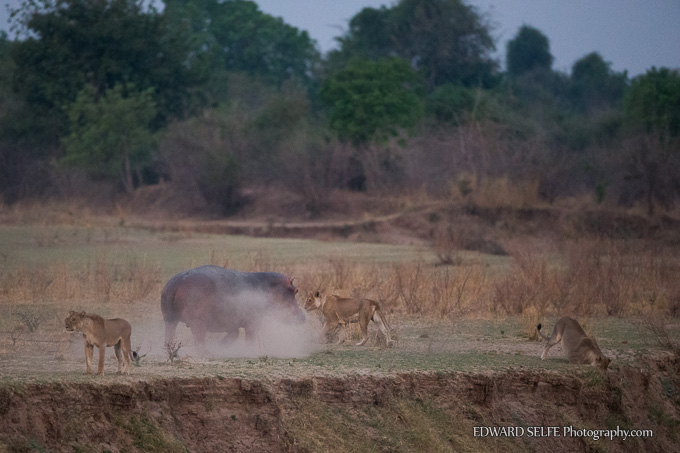
We followed the lions for a while, and they startled a few terrified bushbuck, but didn’t catch anything. So we returned to camp, searching for nocturnals on the way back. Not far out from the camp, we saw a Honey Badger nearby the road…..and it didn’t run away. Most unusual for these creatures. We approached slowly and found that it was feeding on the first in a clutch of dung beetle larvae that it had located underground. It was digging up the dung balls, biting into the hard out casing and eating the larva inside. While we watched, it made 3 trips to the hole, brought out a ball, and then lay down to eat the contents. I had never seen such a relaxed Honey Badger, and I guess it was just keen not to give up its latest stash.
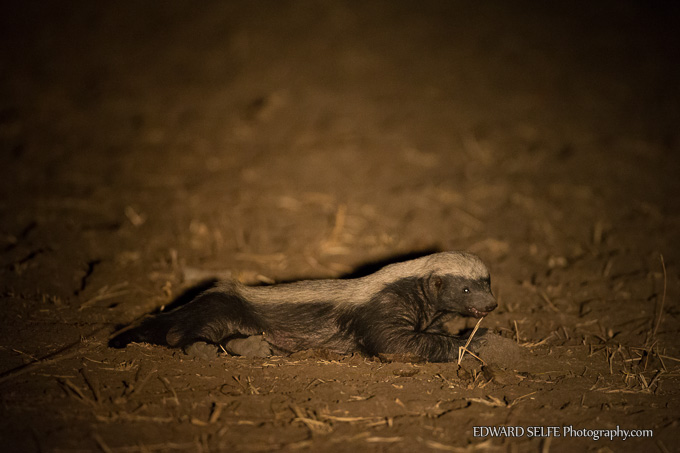
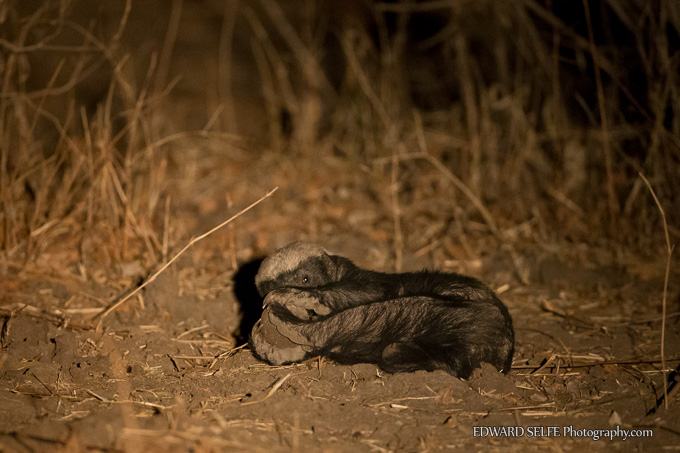
Just outside camp, a Genet watched us from a tree, before hopping down to begin a night of hunting.
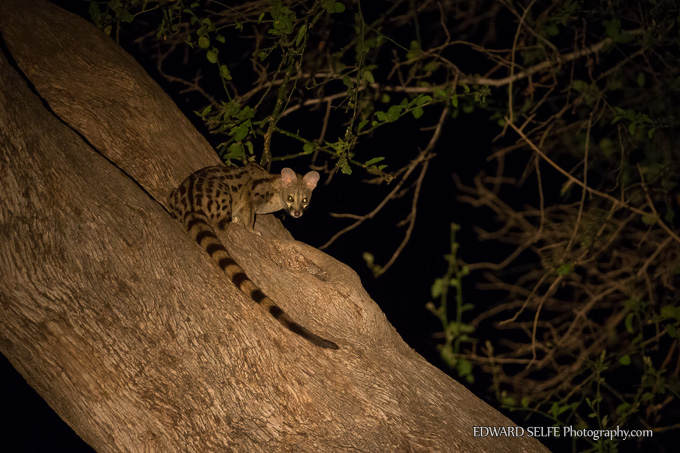
OVERNIGHT AT ZIKOMO SAFARI CAMP
We wanted to visit the salt-pans in the centre of the Nsefu Sector the following day, so set out early to cover the 20kms to the source. It is the only water in an otherwise dry plain, so there’s always a lot of game around it. However, most of the game comes later in the day when the predators are resting in the shade, so early morning it’s a bit of a lottery as there might be predators around, or there might not yet be anything at all!
We had been playing with backlighting throughout the trip, and continued this theme with some zebras on Mtanda plain.
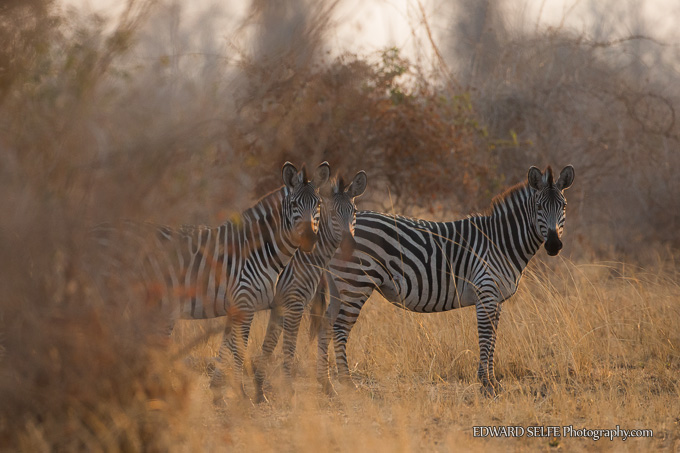
Arriving at the pans, we found a hyaena resting in the cool water, and a small herd of bull buffaloes coming to drink at the source of the spring.
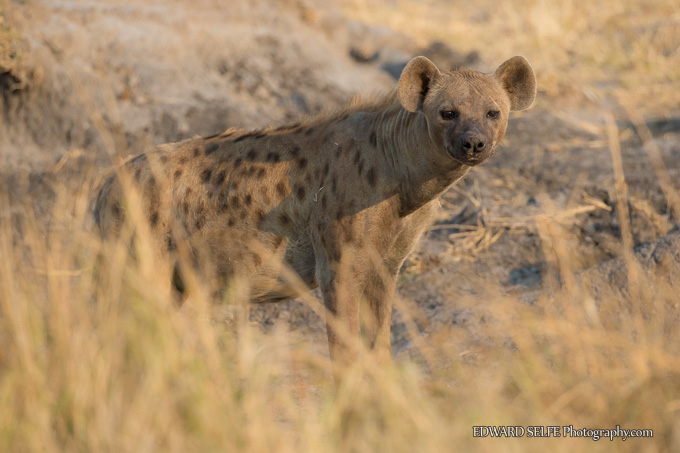
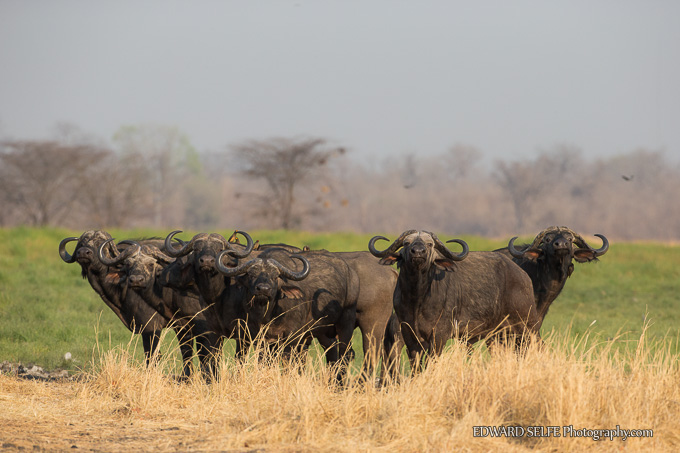
But there wasn’t much else that day, so we had some coffee and then started our journey back. Almost immediately, a Bateleur presented a nice portrait opportunity, sitting tight in a tree right by the road.
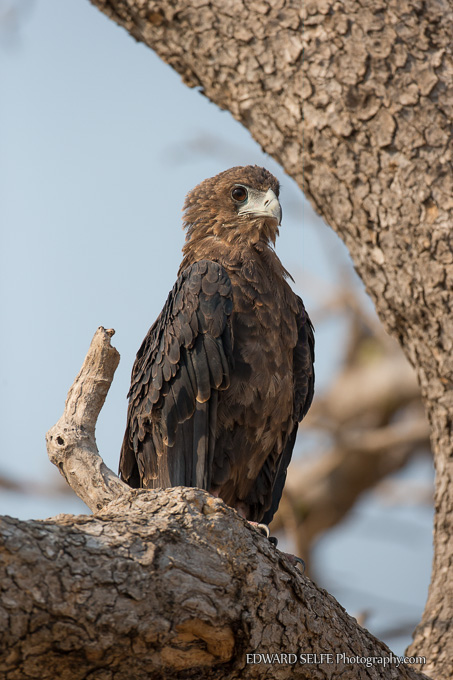
Close to camp, the elephants were having a convention in the river. We counted over 70 along a 200m stretch of river bank, many of the herds muddled together in a frenzy of greetings, bellows and tree-trunk legs. The light was harsh so we took a couple of ‘record photos’ and then just watched the display!
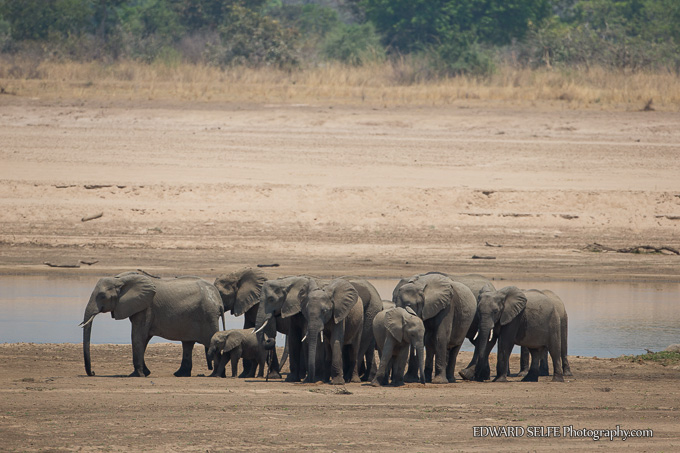
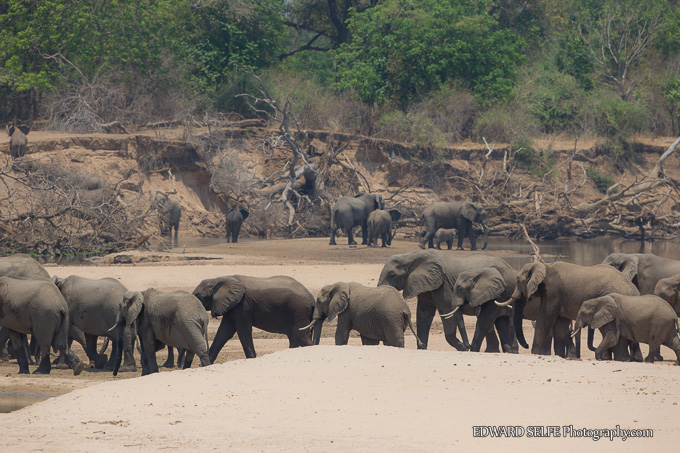
******************************************************
Day 9:
We were all aware that this was our final day on safari, and we wanted to get the best from it. My guests had a couple of things they wanted to see/photgraph, including wild dogs, an elephant silhouette at sunset and an impala leaping across golden grass, with the sun behind it. Nothing too demanding then!
We didn’t succeed in all our missions, but we did have a great day. There weren’t any wild dogs at the salt pans when we passed by, but there were giraffes nearby and a fantastic family of elephants in the halophytic grasses at the bottom of the salt stream.
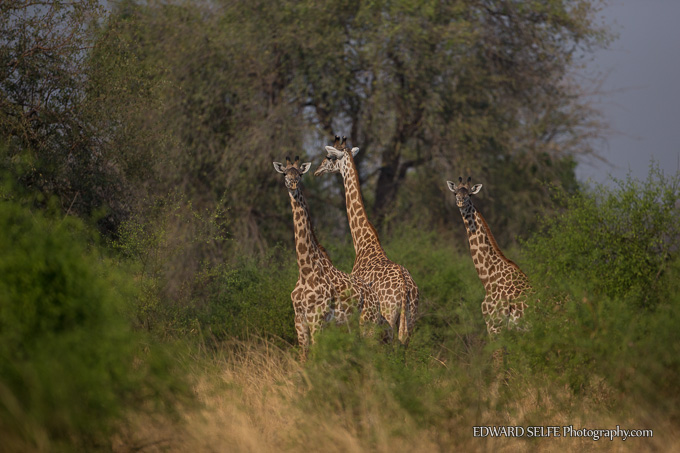
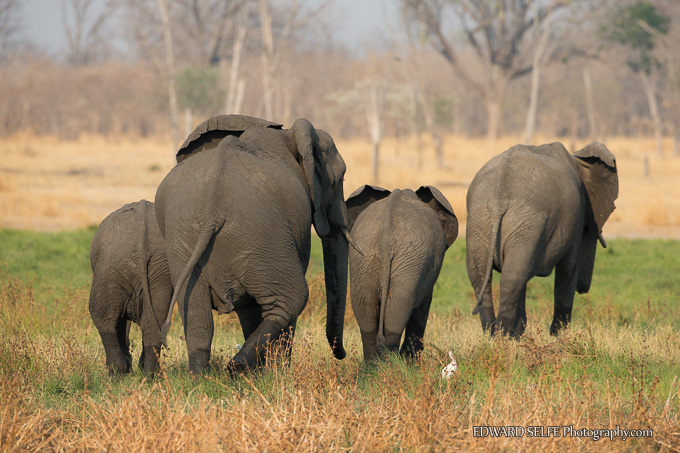
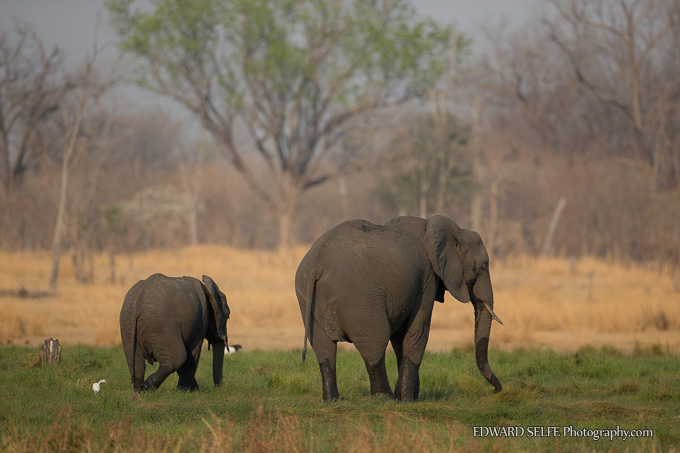
Rushing across Mtanda Plain to find impalas and elephants for sunset, we spotted a puku backlit in the low-light and decided that he might be the ‘impala’. He didn’t want to jump anywhere though, and just stood regally, surveying his surroundings.
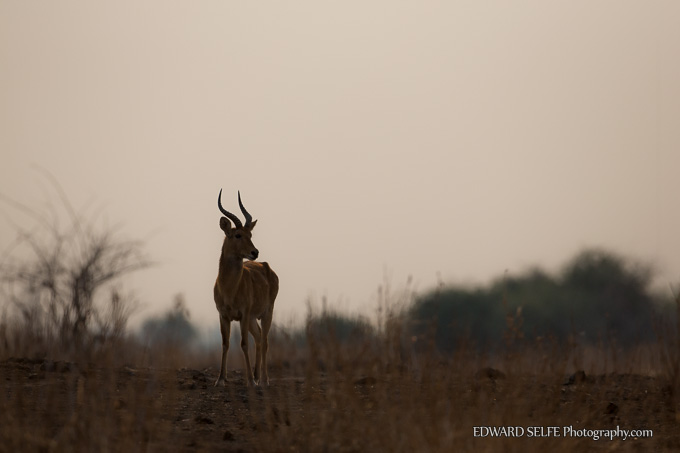
Elephants were everywhere, but not in a position where we could get a silhouette. We couldn’t ignore this stretched out family though, as they cruised across the plain in search of a night’s forage.
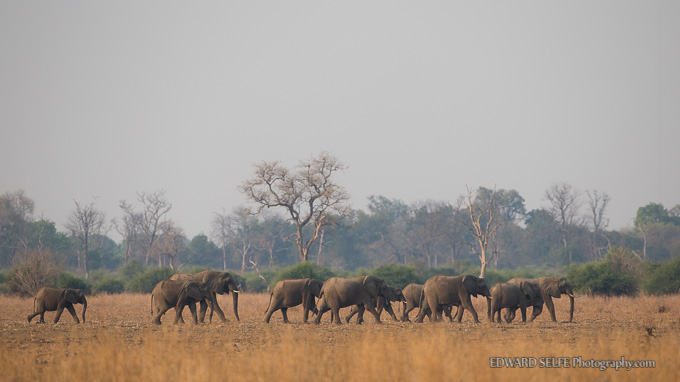
And coming along the river, where the habitat changes dramatically, we started to see zebra and other plains game. These two were happily munching on Sausage fruits.
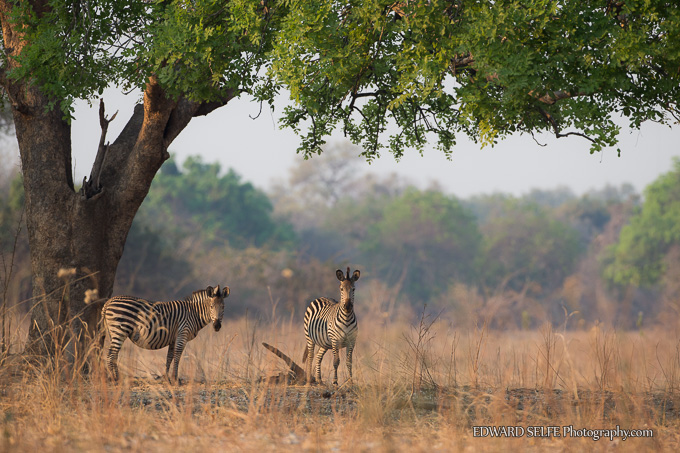
And finally, in the distance, I caught sight of a herd of elephants on the other side of a river channel, where we would be able to drive down below them and take shots against the sunset. We rushed over, trying hard not to spook the herd, and snapped away happily as the sun got lower and lower.
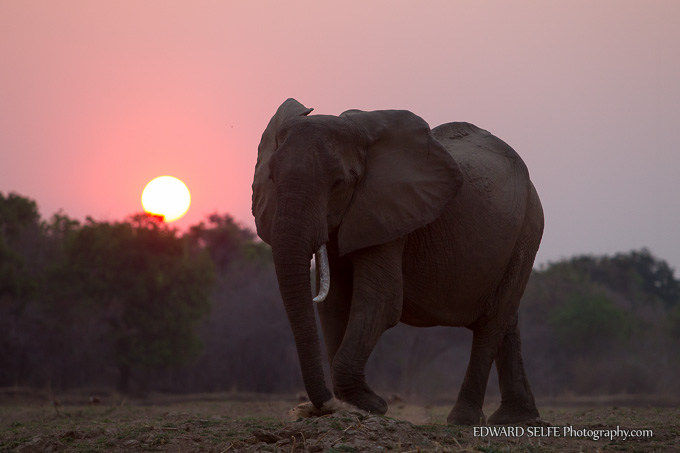
With the sun gone, we drove up out of the channel and parked in the path of the elephants, 200m ahead of them, hoping to get some photos as they walked towards us.
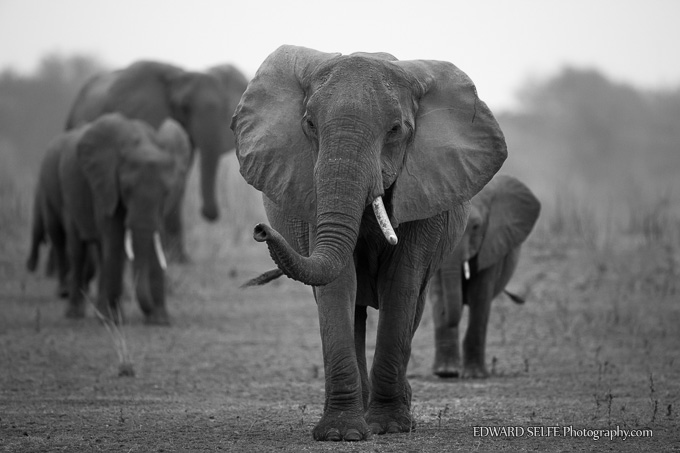
Nearby, a lion called, which was an exciting addition to our evening. With the help of the spotlight, we found him, his brother and all the females.
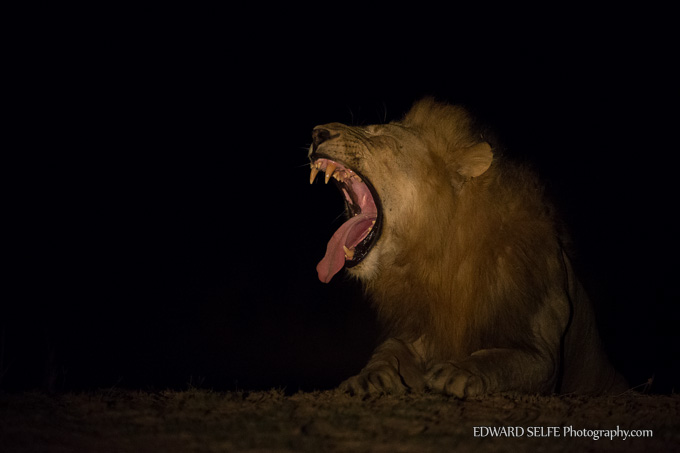
OVERNIGHT AT ZIKOMO SAFARI CAMP
By the time our final morning arrived, we were all tired, and decided that we would take a quiet drive around the nearby area, not rushing off on a mission to find anything particular, but just to see what came if we drove slowly and listened to the bush. It turns out there was a lot to see, and we caught photo chances that we would have missed if we’d been moving faster.
A large bull elephant was returning to the park after a night of foraging elsewhere.
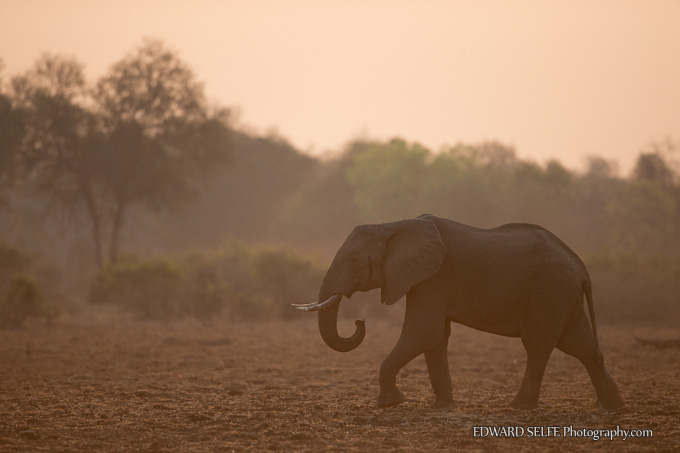
And baboons were playing and feeding under a grove of Sausage trees. I had plenty of chances to try more long lens animal-scapes.
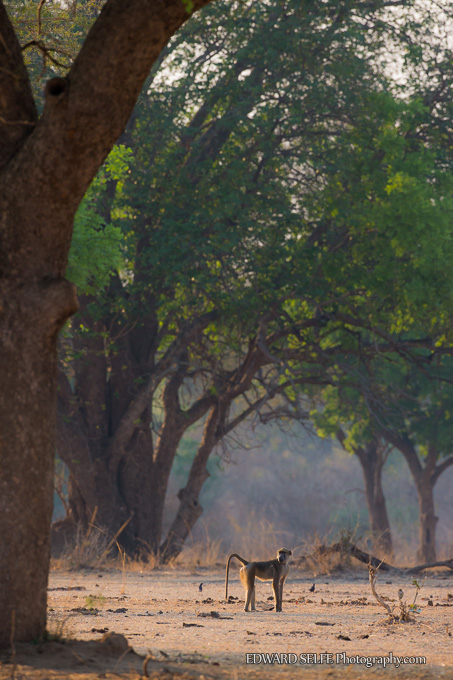
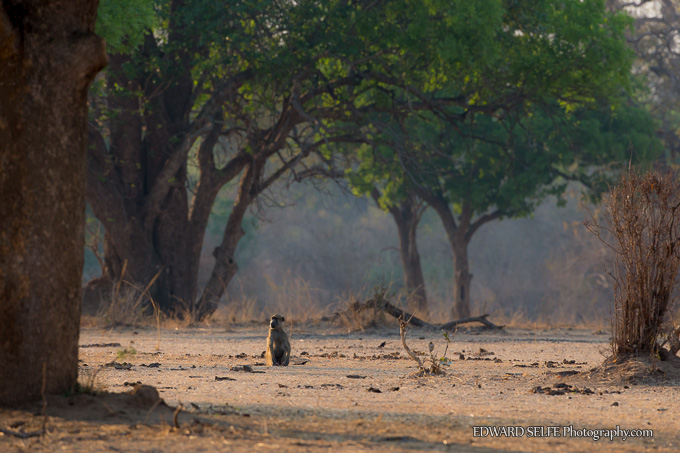
Heading back to the river, we played with a large pod of hippos.
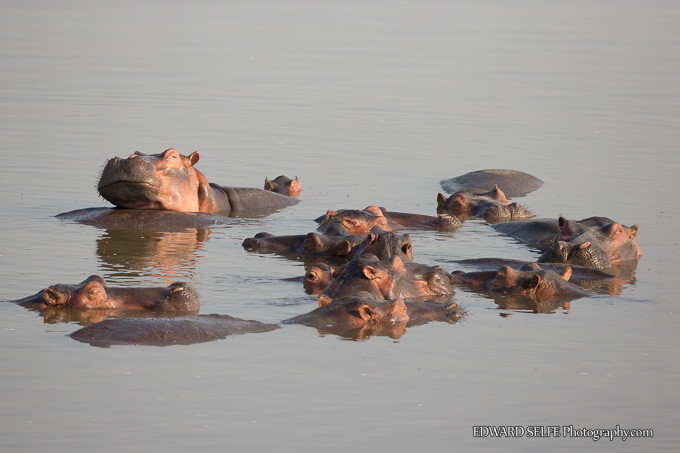
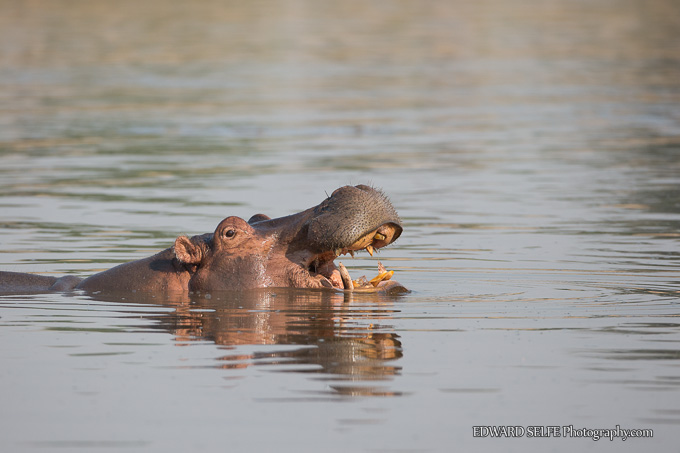
While we waited, a large herd of elephants came down to cross, and a Carmine bee-eater came for a dip in the water to cool down.
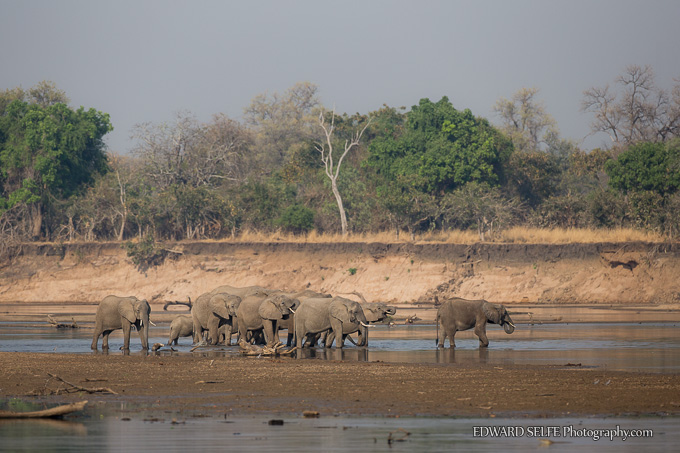
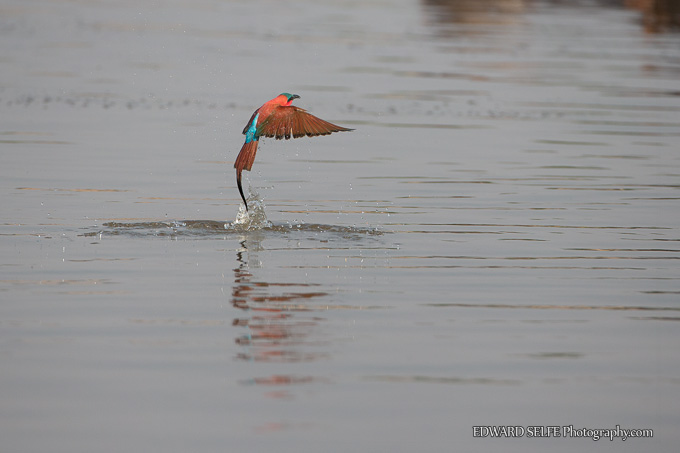
Elephants were a fitting end to our safari, and we spent around an hour with a herd on the last morning, just soaking up the scene and taking occasional photos when good situations arose.
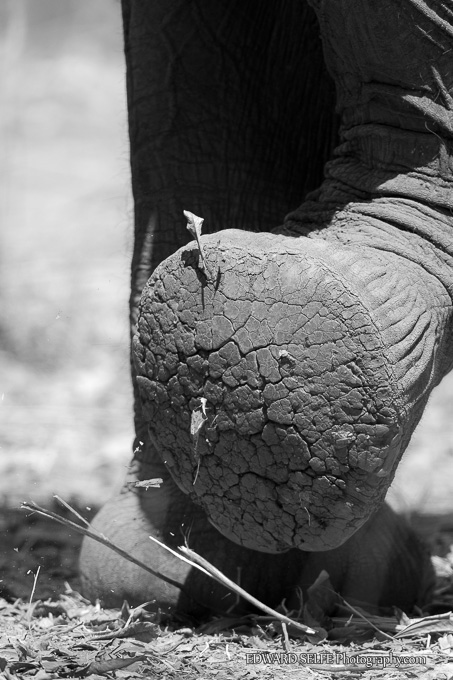
******************************************************
If you would like to join me on safari in 2015, please have a look at my safaris page above. I have set-departure trips, but I also have links with many camps in the area so can put together bespoke trips for groups to fit most budgets. I look forward to hearing from you and perhaps showing you around this stunning place.
******************************************************
Ed

